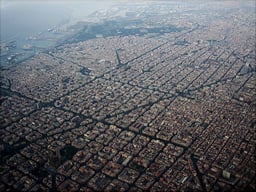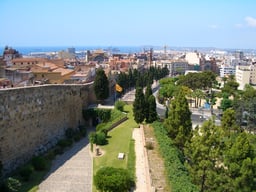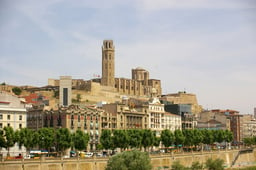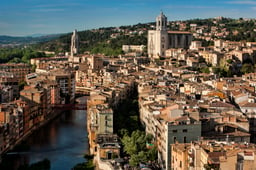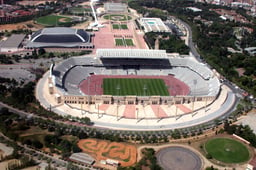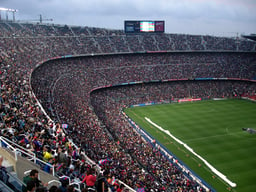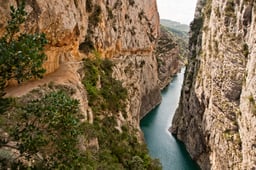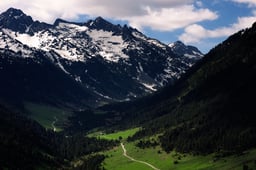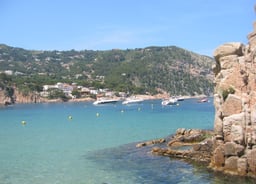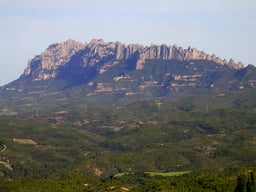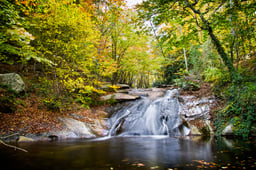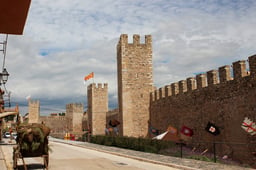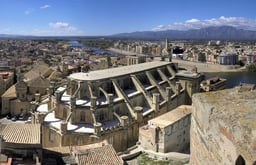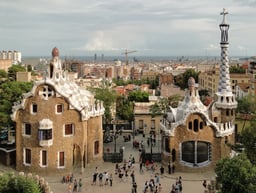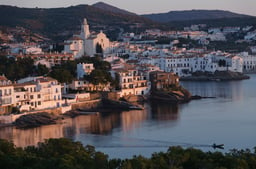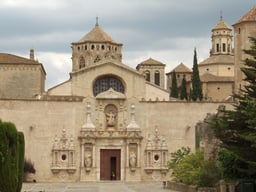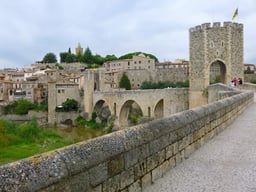Catalonia
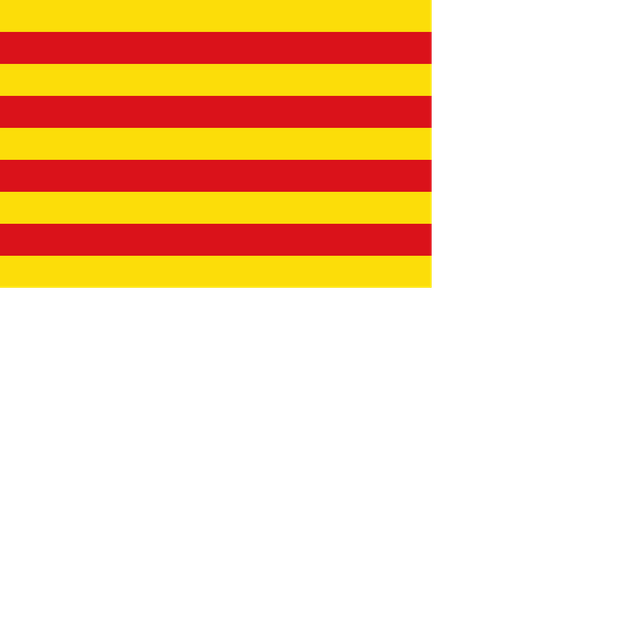
Catalonia

Catalonia
| |
|---|---|
| Anthem: Els Segadors(Catalan) "The Reapers" | |
 Location of Catalonia (red) in Spain | |
 Location of Catalonia (dark green)– in Europe (green & dark grey) – in Spain (green) | |
| Coordinates:41°49′N 1°28′E [200] | |
| Country | Spain |
| Status | Autonomous community (styled as nationality) |
| Formation | 988 (Catalan Counties) 1137 (Union with Aragon) 1283 (Catalan constitutions) 1469 (Union of Castile and Aragon under Catholic Monarchs) 1716 (Nueva Planta decrees) |
| Statute of Autonomy | 9 September 1932 18 September 1979 9 August 2006 (current version) |
| Capital and largest city | Barcelona 41°23′N 2°11′E [201] |
| Provinces | ****Barcelona, Girona, Lleida, Tarragona |
| Government | |
| • Type | Devolved government in a constitutional monarchy |
| • Body | Generalitat of Catalonia |
| • President | Quim Torra (JuntsxCat) |
| • Legislature | Parliament |
| • Congress of Deputies | 48 Deputies (of 350) |
| • Senate | 24 Senators (of 265) |
| Area | |
| • Total | 32,108 km2(12,397 sq mi) |
| Area rank | 6th in Spain |
| Population (2016) | |
| • Total | 7,522,596[4] |
| • Rank | 2nd in Spain (16%) |
| • Density | 234/km2(610/sq mi) |
| Demonyms | Catalan or Catalonian català, -ana (ca) catalán, -ana (es) catalan, -a (oc) |
| GDP (nominal; 2017)[6] | |
| • Total | €224 billion |
| • Per capita | €30,100 |
| GDP (PPP; 2017)[7] | |
| • Total | $343 billion |
| • Per capita | $46,024 |
| Time zone | UTC+1 (CET) |
| • Summer (DST) | UTC+2 (CEST) |
| Area code | +34 93 (Barcelona area) +34 97 (rest of Catalonia) |
| ISO 3166 code | ES-CT |
| Official languages | Catalan, Occitan (Aranese),[1] Spanish,[2] Catalan Sign Language (also recognised) |
| Patron saints | Saint George (Sant Jordi), Virgin of Montserrat |
| HDI (2017) | 0.905[10] very high· 4th |
| Website | gencat.cat [202] |
| Nationality | Population |
| 211,192 | |
| 89,177 | |
| 59,380 | |
| 55,823 | |
| 45,125 | |
| 33,728 | |
| 33,184 | |
| 30,095 | |
| 29,853 | |
| 25,749 | |
| 24,224 | |
| 23,103 | |
| 22,305 | |
| 20,828 | |
| 20,127 | |
| 19,445 | |
| 19,192 | |
| 18,917 | |
| 18,620 | |
| 18,002 | |
| 16,933 | |
| 14,209 | |
| 13,847 | |
| 12,491 | |
| 11,288 | |
| 11,061 | |
Catalonia (/ˌkætəˈloʊniə/; Catalan: Catalunya [kətəˈluɲə]; Aranese: Catalonha [kataˈluɲɔ]; Spanish: Cataluña [kataˈluɲa]) is an autonomous community on the northeastern corner of Spain, designated as a nationality by its Statute of Autonomy.[3][12] Catalonia consists of four provinces: Barcelona, Girona, Lleida, and Tarragona. The capital and largest city is Barcelona, the second-most populated municipality in Spain and the core of the sixth most populous urban area in the European Union.[13] It comprises most of the territory of the former Principality of Catalonia (with the remainder Roussillon now part of France's Pyrénées-Orientales, Occitanie). It is bordered by France (Occitanie) and Andorra to the north, the Mediterranean Sea to the east, and the Spanish autonomous communities of Aragon to the west and Valencia to the south. The official languages are Catalan, Spanish, and the Aranese dialect of Occitan.[14]
In the late 8th century, the counties of the March of Gothia and the Hispanic March were established by the Frankish kingdom as feudal vassals across and near the eastern Pyrenees as a defensive barrier against Muslim invasions. The eastern counties of these marches were united under the rule of the Frankish vassal, the count of Barcelona. In the 10th century the County of Barcelona became independent de facto.[15] In 1137, Barcelona and the Kingdom of Aragon were united by marriage under the Crown of Aragon. The de jure end of Frankish rule was ratified by French and Aragonese monarchs in the Treaty of Corbeil in 1258.[16] The Principality of Catalonia developed its own institutional system, such as courts (parliament), and constitutions, becoming the base for the Crown of Aragon's naval power, trade and expansionism in the Mediterranean. In the later Middle Ages, Catalan literature flourished. During the last Medieval centuries natural disasters, social turmoils and military conflicts affected the Principality. Between 1469 and 1516, the king of Aragon and the queen of Castile married and ruled their realms together, retaining all of their distinct institutions and legislation.
During the Franco-Spanish War (1635–1659), Catalonia revolted (1640–1652) against a large and burdensome presence of the royal army in its territory, being briefly proclaimed a republic under French protection. Within a brief period France took full control of Catalonia, until it was largely reconquered by the Spanish army. Under the terms of the Treaty of the Pyrenees in 1659, the Spanish Crown ceded the northern parts of Catalonia, mostly the County of Roussillon, to France. During the War of the Spanish Succession (1701–1714), the Crown of Aragon sided against the Bourbon Philip V of Spain; following Catalan defeat on 11 September 1714, Philip V, inspired by the model of France imposed a unifying administration across Spain, enacting the Nueva Planta decrees, suppressing the main Catalan institutions and rights like in the other realms of the Crown of Aragon. This led to the eclipse of Catalan as a language of government and literature, replaced by Spanish. Along the 18th century, Catalonia experienced economic growth, reinforced in the late quarter of the century when the Castile's trade monopoly with American colonies ended.
In the 19th century, Catalonia was severely affected by the Napoleonic and Carlist Wars. In the second third of the century, Catalonia experienced significant industrialisation. As wealth from the industrial expansion grew, Catalonia saw a cultural renaissance coupled with incipient nationalism while several workers movements appeared. In 1914, the four Catalan provinces formed a commonwealth, and with the return of democracy during the Second Spanish Republic (1931–1939), the Generalitat of Catalonia was restored as an autonomous government. After the Spanish Civil War, the Francoist dictatorship enacted repressive measures, abolishing Catalan self-government and banning the official use of the Catalan language again. After a first period of autarky, from the late 1950s through to the 1970s Catalonia saw rapid economic growth, drawing many workers from across Spain, making Barcelona one of Europe's largest industrial metropolitan areas and turning Catalonia into a major tourist destination. Since the Spanish transition to democracy (1975–1982), Catalonia has regained considerable autonomy in political, educational, environmental, and cultural affairs and is now one of the most economically dynamic communities of Spain. In the 2010s there has been growing support for Catalan independence. On 27 October 2017, the Catalan Parliament declared independence from Spain following a disputed referendum. The Spanish Senate voted in favour of enforcing direct rule by removing the entire Catalan government and calling a snap regional election for 21 December. On 2 November of the same year, the Spanish Supreme Court imprisoned seven former ministers of the Catalan government on charges of rebellion and misuse of public funds, while several others—including then-President of Catalonia, Carles Puigdemont—fled to other European countries (such as Belgium, in Puigdemont's case).
Catalonia
| |
|---|---|
| Anthem: Els Segadors(Catalan) "The Reapers" | |
 Location of Catalonia (red) in Spain | |
 Location of Catalonia (dark green)– in Europe (green & dark grey) – in Spain (green) | |
| Coordinates:41°49′N 1°28′E [200] | |
| Country | Spain |
| Status | Autonomous community (styled as nationality) |
| Formation | 988 (Catalan Counties) 1137 (Union with Aragon) 1283 (Catalan constitutions) 1469 (Union of Castile and Aragon under Catholic Monarchs) 1716 (Nueva Planta decrees) |
| Statute of Autonomy | 9 September 1932 18 September 1979 9 August 2006 (current version) |
| Capital and largest city | Barcelona 41°23′N 2°11′E [201] |
| Provinces | ****Barcelona, Girona, Lleida, Tarragona |
| Government | |
| • Type | Devolved government in a constitutional monarchy |
| • Body | Generalitat of Catalonia |
| • President | Quim Torra (JuntsxCat) |
| • Legislature | Parliament |
| • Congress of Deputies | 48 Deputies (of 350) |
| • Senate | 24 Senators (of 265) |
| Area | |
| • Total | 32,108 km2(12,397 sq mi) |
| Area rank | 6th in Spain |
| Population (2016) | |
| • Total | 7,522,596[4] |
| • Rank | 2nd in Spain (16%) |
| • Density | 234/km2(610/sq mi) |
| Demonyms | Catalan or Catalonian català, -ana (ca) catalán, -ana (es) catalan, -a (oc) |
| GDP (nominal; 2017)[6] | |
| • Total | €224 billion |
| • Per capita | €30,100 |
| GDP (PPP; 2017)[7] | |
| • Total | $343 billion |
| • Per capita | $46,024 |
| Time zone | UTC+1 (CET) |
| • Summer (DST) | UTC+2 (CEST) |
| Area code | +34 93 (Barcelona area) +34 97 (rest of Catalonia) |
| ISO 3166 code | ES-CT |
| Official languages | Catalan, Occitan (Aranese),[1] Spanish,[2] Catalan Sign Language (also recognised) |
| Patron saints | Saint George (Sant Jordi), Virgin of Montserrat |
| HDI (2017) | 0.905[10] very high· 4th |
| Website | gencat.cat [202] |
| Nationality | Population |
| 211,192 | |
| 89,177 | |
| 59,380 | |
| 55,823 | |
| 45,125 | |
| 33,728 | |
| 33,184 | |
| 30,095 | |
| 29,853 | |
| 25,749 | |
| 24,224 | |
| 23,103 | |
| 22,305 | |
| 20,828 | |
| 20,127 | |
| 19,445 | |
| 19,192 | |
| 18,917 | |
| 18,620 | |
| 18,002 | |
| 16,933 | |
| 14,209 | |
| 13,847 | |
| 12,491 | |
| 11,288 | |
| 11,061 | |
Etymology and pronunciation
The name Catalonia—Catalunya in Catalan, spelled Cathalonia, or Cathalaunia in Medieval Latin—began to be used for the homeland of the Catalans (Cathalanenses) in the late 11th century and was probably used before as a territorial reference to the group of counties that comprised part of the March of Gothia and March of Hispania under the control of the Count of Barcelona and his relatives.[17] The origin of the name Catalunya is subject to diverse interpretations because of a lack of evidence.
One theory suggests that Catalunya derives from the name Gothia (or Gauthia) Launia ("Land of the Goths"), since the origins of the Catalan counts, lords and people were found in the March of Gothia, known as Gothia, whence Gothland > Gothlandia > Gothalania > Cathalaunia > Catalonia theoretically derived.[18][19] During the Middle Ages, Byzantine chroniclers claimed that Catalania derives from the local medley of Goths with Alans, initially constituting a Goth-Alania.[20]
Other less plausible or recent theories suggest:
Catalunya derives from the term "land of castles", having evolved from the term castlà or castlan, the medieval term for a castellan (a ruler of a castle).[18][21] This theory therefore suggests that the names Catalunya and Castile have a common root.
The source is of Celtic origin, meaning "chiefs of battle". Although the area is not known to have been occupied by the Celtiberians, a Celtic culture was present within the interior of the Iberian Peninsula in pre-Roman times.[22]
The Lacetani, an Iberian tribe that lived in the area and whose name, due to the Roman influence, could have evolved by metathesis to Katelans and then Catalans.[23]
Miguel Vidal, finding serious shortcomings with earlier proposals (such as that an original -t- would have, by normal sound laws in the local Romance languages, developed into -d-), suggested an Arabic etymology: qattāl (قتالو, pl. qattālūn قتالون) – meaning "killer" – could have been applied by Muslims to groups of raiders and bandits on the southern border of the Marca Hispanica.[24] The name, originally derogatory, could have been reappropiated by Christians as an autonym. This is comparable to attested development of the term Almogavar in nearby areas. In this model, the name Catalunya derives from the plural qattālūn while the adjective and language name català derives from the singular qattāl, both with the addition of common Romance suffixes.[25]
In English, Catalonia is pronounced /kætəˈloʊniə/. The native name, Catalunya, is pronounced [kətəˈluɲə] in Central Catalan, the most widely spoken variety, whose pronunciation is considered standard.[26] The Spanish name is Cataluña ([kataˈluɲa]), and the Aranese name is Catalonha ([kataˈluɲɔ]).
History
Prehistory

The Roca dels Moros contain paintings protected as part of the Rock art of the Iberian Mediterranean Basin, a World Heritage Site
The first known human settlements in what is now Catalonia were at the beginning of the Middle Paleolithic. The oldest known trace of human occupation is a mandible found in Banyoles, described by some sources as pre-Neanderthal some 200,000 years old; other sources suggest it to be only about one third that old.[27] From the next prehistoric era, the Epipalaeolithic or Mesolithic, important remains survive, the greater part dated between 8000 and 5000 BC, such as those of Sant Gregori (Falset) and el Filador (Margalef de Montsant). The most important sites from these eras, all excavated in the region of Moianès, are the Balma del Gai (Epipaleolithic) and the Balma de l'Espluga (late Epipaleolithic and Early Neolithic).[28]
The Neolithic era began in Catalonia around 5000 BC, although the population was slower to develop fixed settlements than in other places, thanks to the abundance of woods, which allowed the continuation of a fundamentally hunter-gatherer culture. An example of such settlements would be La Draga, an "early Neolithic village which dates from the end of the 6th millennium BC."[29]
The Chalcolithic period developed in Catalonia between 2500 and 1800 BC, with the beginning of the construction of copper objects. The Bronze Age occurred between 1800 and 700 BC. There are few remnants of this era, but there were some known settlements in the low Segre zone. The Bronze Age coincided with the arrival of the Indo-Europeans through the Urnfield Culture, whose successive waves of migration began around 1200 BC, and they were responsible for the creation of the first proto-urban settlements.[30] Around the middle of the 7th century BC, the Iron Age arrived in Catalonia.
Pre-Roman and Roman period
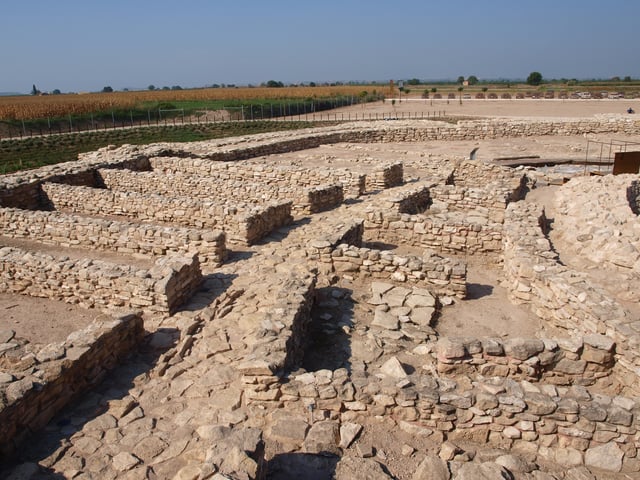
Iberian fortress Els Vilars in Arbeca

A Roman aqueduct in Tarragona
In pre-Roman times, the area that is now called Catalonia in the north-east of Iberian Peninsula – like the rest of the Mediterranean side of the peninsula – was populated by the Iberians. The Iberians of this area – the Ilergetes, Indigetes and Lacetani (Cerretains) – also maintained relations with the peoples of the Mediterranean. Some urban agglomerations became relevant, including Ilerda (Lleida) inland, Hibera (perhaps Amposta or Tortosa) or Indika (Ullastret). Coastal trading colonies were established by the ancient Greeks, who settled around the Gulf of Roses, in Emporion (Empúries) and Roses in the 8th century BC. The Carthaginians briefly ruled the territory in the course of the Second Punic War and traded with the surrounding Iberian population.
After the Carthaginian defeat by the Roman Republic, the north-east of Iberia became the first to come under Roman rule and became part of Hispania, the westernmost part of the Roman Empire. Tarraco (modern Tarragona) was one of the most important Roman cities in Hispania and the capital of the province of Tarraconensis. Other important cities of the Roman period are Ilerda (Lleida), Dertosa (Tortosa), Gerunda (Girona) as well as the ports of Empuriæ (former Emporion) and Barcino (Barcelona). As for the rest of Hispania, Latin law was granted to all cities under the reign of Vespasian (69-79 AD), while Roman citizenship was granted to all free men of the empire by the Edict of Caracalla in 212 AD (Tarraco, the capital, was already a colony of Roman law since 45 BC). It was a rich agricultural province (olive oil, vine, wheat), and the first centuries of the Empire saw the construction of roads (the most important being the Via Augusta, parallel to Mediterranean coastline) and infrastructure like aqueducts.
Conversion to Christianity, attested in the 3rd century, was completed in urban areas in the 4th century. Although Hispania remained under Roman rule and did not fall under the rule of Vandals, Swabians and Alans in the 5th century, the main cities suffered frequent sacking and some deurbanization.
Middle Ages
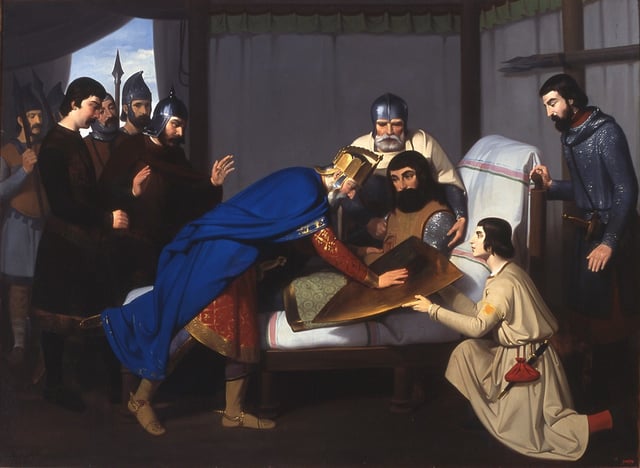
Origins of the blason of the County of Barcelona, by Claudi Lorenzale
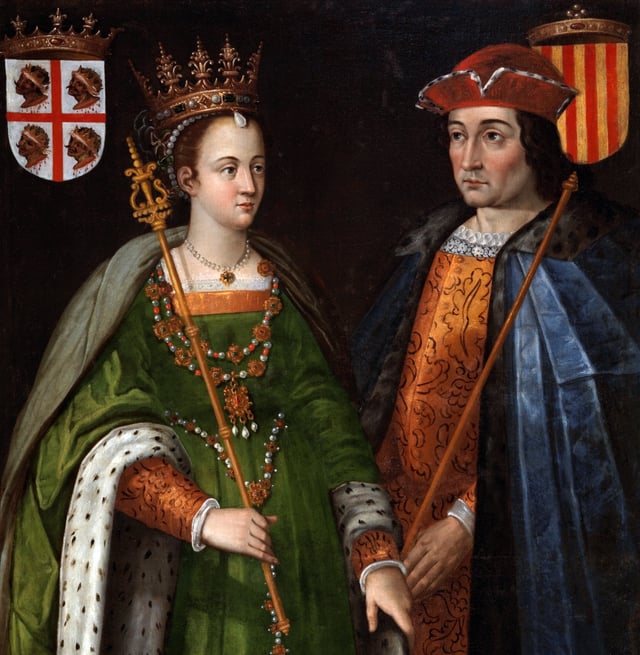
Petronilla of Aragon and Ramon Berenguer IV, Count of Barcelona, dynastic union of the Crown of Aragon
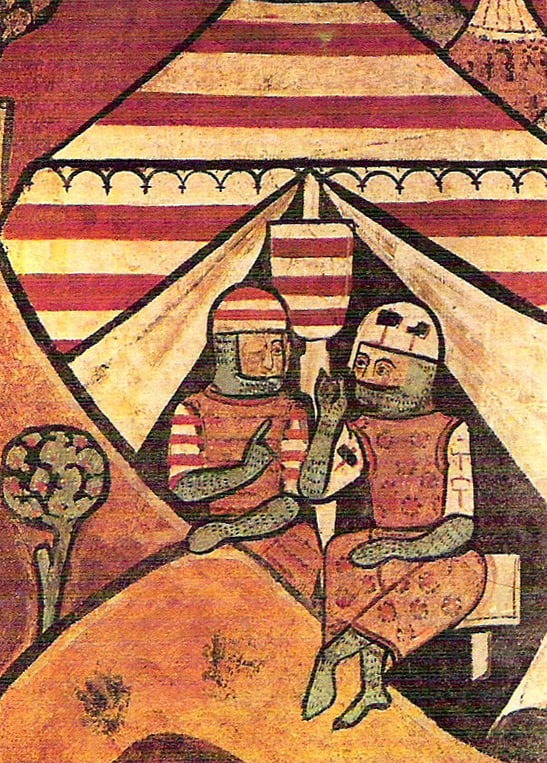
Hug IV, count of Empúries, and Pero Maça during the conquest of Mallorca (1229)
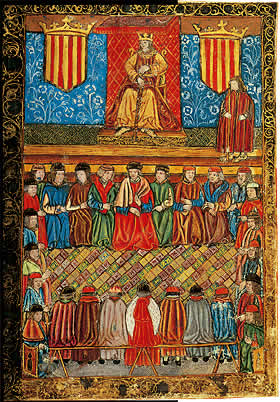
A 15th-century miniature of the Catalan Courts
After the fall of the Western Roman Empire, the area was conquered by the Visigoths and was ruled as part of the Visigothic Kingdom for almost two and a half centuries. In 718, it came under Muslim control and became part of Al-Andalus, a province of the Umayyad Caliphate. From the conquest of Roussillon in 760, to the conquest of Barcelona in 801, the Frankish empire took control of the area between Septimania and the Llobregat river from the Muslims and created heavily militarised, self-governing counties. These counties formed part of the Gothic and Hispanic marches, a buffer zone in the south of the Frankish empire in the former province of Septimania and in the northeast of the Iberian Peninsula, to act as a defensive barrier for the Frankish empire against further Muslim invasions from Al-Andalus.
These counties came under the rule of the counts of Barcelona, who were Frankish vassals nominated by the emperor of the Franks, to whom they were feudatories (801–987). The earliest known use of the name "Catalonia" for these counties dates to 1117. During the 9th century, the Count Wifred the Hairy made its title hereditary and founded the dynasty of the House of Barcelona, which ruled Catalonia until 1410.
In 987 Borrell II, Count of Barcelona, did not recognise the new French king Hugh Capet as his king, making his successors (from Ramon Borrell I to Ramon Berenguer IV) de facto independent of the Capetian crown whom they regarded as usurpers of the Carolingian Frankish realm.[31] At the start of eleventh century the Catalan Counties suffer an important process of feudalisation, partially controlled by the Peace and Truce Assemblies and by the power and negotiation skills of the Counts of Barcelona like Ramon Berenguer I. In 1137, Ramon Berenguer IV, Count of Barcelona decided to accept King Ramiro II of Aragon's proposal to marry Queen Petronila, establishing the dynastic union of the County of Barcelona with the Kingdom of Aragon, joining the Crown of Aragon and making the Catalan counties that were united under the county of Barcelona into a principality of the Aragonese Crown.
In 1258, by means of the Treaty of Corbeil, the Count of Barcelona and King of Aragon, of Mallorca and of Valencia, James I of Aragon renounced his family rights and dominions in Occitania and recognised the king of France as heir of the Carolingian Dynasty. The king of France formally relinquished his nominal feudal lordship over all the Catalan counties, except the County of Foix, despite the opposition of the king of Aragon and count of Barcelona. This treaty transformed the principality's de facto union with Aragon into a de jure one and was the origin of the definitive separation between the geographical areas of Catalonia and Languedoc.
As a coastal territory, Catalonia became the base of the Aragonese Crown's maritime forces, which spread the power of the Aragonese Crown in the Mediterranean, and made Barcelona into a powerful and wealthy city. In the period of 1164–1410, new territories, the Kingdom of Valencia, the Kingdom of Majorca, Sardinia, the Kingdom of Sicily, Corsica, and (briefly) the Duchies of Athens and Neopatras, were incorporated into the dynastic domains of the House of Aragon.
At the same time, the Principality of Catalonia developed a complex institutional and political system based in the concept of a pact between the estates of the realm and the king. Laws had to be approved in the General Court of Catalonia, one of the first parliamentary bodies of Europe that banned the royal power to create legislation unilaterally (since 1283).[32] The Courts were composed of the three Estates, were presided over by the king of Aragon, and approved the constitutions, which created a compilation of rights for the citizenship of the Principality. In order to collect general taxes, the Courts of 1359 established a permanent representative of deputies position, called the Deputation of the General (and later usually known as Generalitat), which gained political power over the next centuries.[33]
The domains of the Aragonese Crown were severely affected by the Black Death pandemic and by later outbreaks of the plague. Between 1347 and 1497 Catalonia lost 37 percent of its population.[34] In 1410, King Martin I died without surviving descendants. Under the Compromise of Caspe, Ferdinand from the Castilian House of Trastámara received the Crown of Aragon as Ferdinand I of Aragon.[35] During the reign of his son, John II, social and political tensions caused the Catalan Civil War (1462–1472).
Modern era
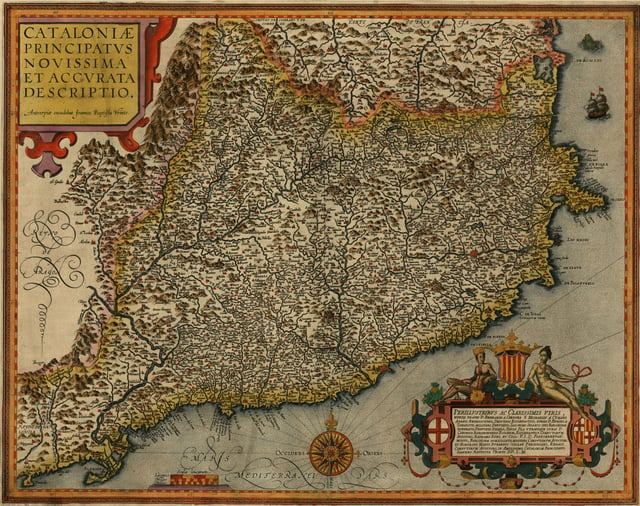
The Principality of Catalonia (1608)
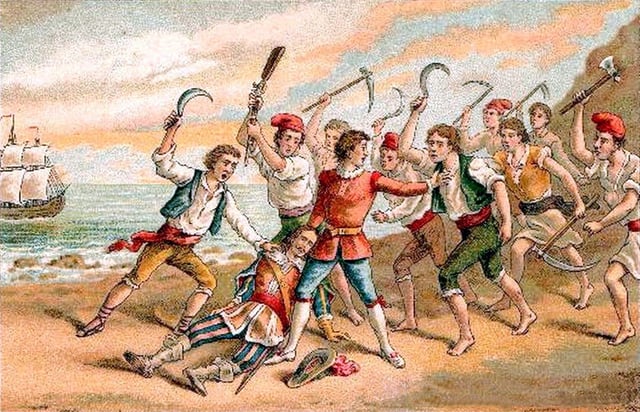
Corpus de Sang (7 June 1640), one of the main events of the Reaper's War. Painted in 1910
Ferdinand II of Aragon, the grandson of Ferdinand I, and Queen Isabella I of Castile were married in 1469, later taking the title the Catholic Monarchs; subsequently, this event was seen by historiographers as the dawn of a unified Spain. At this time, though united by marriage, the Crowns of Castile and Aragon maintained distinct territories, each keeping its own traditional institutions, parliaments, laws and currency.[36] Castile commissioned expeditions to the Americas and benefited from the riches acquired in the Spanish colonisation of the Americas, but, in time, also carried the main burden of military expenses of the united Spanish kingdoms. After Isabella's death, Ferdinand II personally ruled both kingdoms.
By virtue of descent from his maternal grandparents, Ferdinand II of Aragon and Isabella I of Castile, in 1516 Charles I of Spain became the first king to rule the Crowns of Castile and Aragon simultaneously by his own right. Following the death of his paternal (House of Habsburg) grandfather, Maximilian I, Holy Roman Emperor, he was also elected Charles V, Holy Roman Emperor, in 1519.[37]
Over the next few centuries, the Principality of Catalonia was generally on the losing side of a series of wars that led steadily to more centralization of power in Spain. Despite this fact, between the 16th and 18th centuries, the participation of the political community in the local and the general Catalan government was increased, while the kings remained absent and its constitutional system continued to consolidate. The Reapers' War (1640–1652) saw Catalonia rebel (briefly as a republic led by Pau Claris) with French help against the Spanish Crown for overstepping Catalonia's rights during the Thirty Years' War.[38] Most of Catalonia was reconquered by the Spanish monarchy but Catalan rights were recognised. Roussillon was lost to France by the Peace of the Pyrenees (1659).[39]
The most significant conflict concerning the governing monarchy was the War of the Spanish Succession, which began when the childless Charles II of Spain, the last Spanish Habsburg, died without an heir in 1700. Charles II had chosen Philip V of Spain from the French House of Bourbon. Catalonia, like other territories that formed the Crown of Aragon, rose up in support of the Austrian Habsburg pretender Charles VI, Holy Roman Emperor, in his claim for the Spanish throne as Charles III of Spain. The fight between the houses of Bourbon and Habsburg for the Spanish Crown split Spain and Europe.
The fall of Barcelona on 11 September 1714 to the Bourbon king Philip V militarily ended the Habsburg claim to the Spanish Crown, which became legal fact in the Treaty of Utrecht. Philip felt that he had been betrayed by the Catalan Courts, as it had initially sworn its loyalty to him when he had presided over it in 1701. In retaliation for the betrayal, the first Bourbon king introduced the Nueva Planta decrees that incorporated the territories of the Crown of Aragon, including Catalonia, as provinces under the Crown of Castile in 1716, terminating their separate institutions, laws and rights, within a united kingdom of Spain.[40] During the second half of 18th century Catalonia started a successful process of proto-industrialization.
Industrialisation, Republic and autonomy
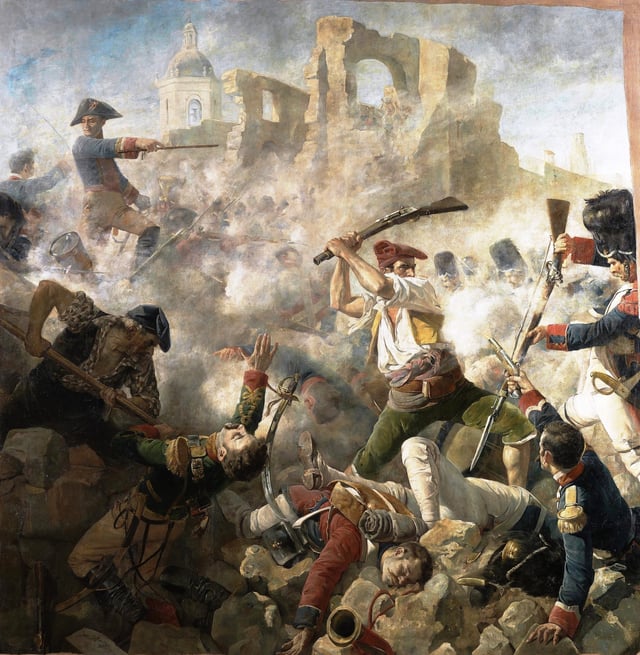
Third Siege of Girona (1809), Peninsular War against Napoleon
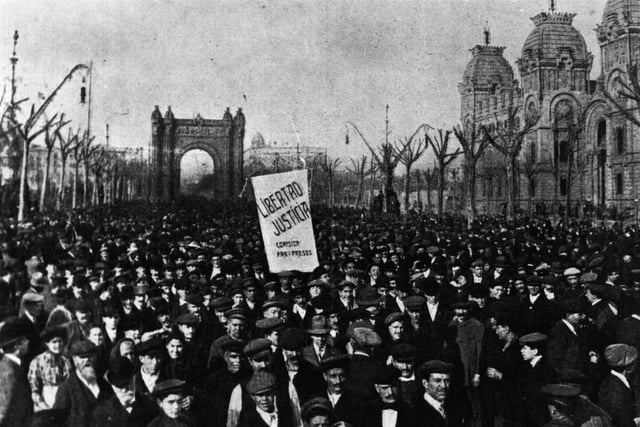
Demonstration after the Tragic Week, 1909
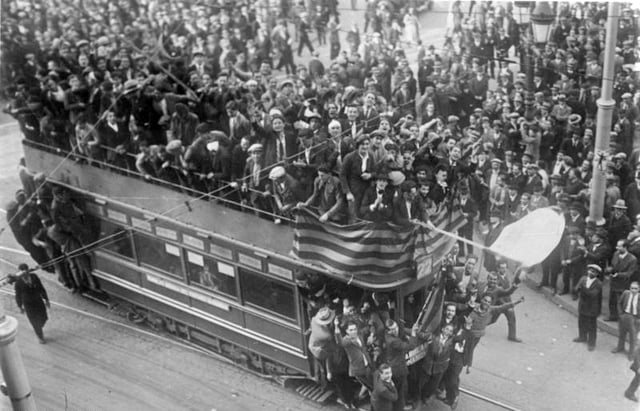
Proclamation of the Second Spanish Republic on 14 April 1931 in Barcelona
At the beginning of the nineteenth century Catalonia was severely affected by the Napoleonic Wars. In 1808 it was occupied by the French troops, the resistance against the occupation eventually developed into the Peninsular War. The rejection to French dominion was institutionalized with the creation of "juntas" (councils) who, remaining loyal to the Bourbons, exercised the sovereignty and representation of the territory due to the disappearance of the old institutions. Napoleon took direct control of Catalonia to establish order, creating the Government of Catalonia under the rule of Marshall Augereau, and making Catalan briefly an official language again. Between 1812 and 1814 Catalonia was annexed to France and organized as four départements.[41] The French troops evacuated Catalan territory at the end of 1814. After the Bourbon restoration in Spain and the death of the abolutist king Ferdinand VII, Carlist Wars erupted against the new born liberal state of Isabella II. Catalonia was divided, the coast and most industrialized areas support liberalism, while many inland areas were in the hands of Carlists, as the last ones proposed to reestablish the intitutional systems suppressed in the Nueva Planta decrees in all the ancient realms of the Crown of Aragon.
In the second third of the 19th century, it became an industrial center. This process was boosted by, amongst other things, national protectionist laws (although the policy of the Spanish government during those times changed many times between free trade and protectionism) and the conditions of proto-industrialization of the prior two centuries of the Catalan urban areas and its countryside. Along the century, textile industry flourished in urban areas and in the countryside, usually in the form of company towns. To this day it remains one of the most industrialised areas of Spain. In 1832 it was inaugurated in Barcelona the factory Bonaplata, the first of the country which worked with steam engine. During those years, Barcelona was the focus of important revolutionary uprisings, called "bullangues", causing a difficult relation between many sectors of Catalan society and the central government and, in Catalonia, a republican current began to develop; also, inevitably, many Catalans favored a more federal Spain. Meanwhile, the Catalan language saw a cultural renaissance (the Renaixença) at popular and bourgeois level. After the fall of the First Spanish Republic and the restoration of the Bourbon dynasty (1874), Catalan nationalism grew in importance.
The Anarchists had been active throughout the early 20th century, founding the CNT trade union and achieving one of the first eight-hour workday in Europe in 1919.[42] Growing resentment of conscription and of the military culminated in the Tragic Week in Barcelona in 1909. In the first third of the 20th century, Catalonia gained and lost varying degrees of autonomy several times. In 1914, the four Catalan provinces were authorized to create a Commonwealth (Mancomunitat), without any legislative power or specific autonomy which carried out an ambitious program of modernization, but that was disbanded in 1925 by the dictatorship of Primo de Rivera (1923-1930). During the last steps of the Dictatorship, Barcelona celebrated the 1929 International Exposition,[43] while Spain started to suffer an economical crisis.
After the fall of the dictator and a brief proclamation of the Catalan Republic,[44] it received its first Statute of Autonomy during the Second Spanish Republic (1931–1939), establishing an autonomous body, the Generalitat of Catalonia, which included a parliament, a government and a court of appeal, and the left-wing independentist leader Francesc Macià was elected its first president. The governments of the Republican Generalitat, led by the Republican Left of Catalonia (ERC) members Francesc Macià (1931-1933) and Lluís Companys (1933-1940) tried to implement an advanced social program, despite the internal difficulties. This period was marked by political unrest, the effects of the economic crisis and their social repercussions. The Statute was suspended in 1934, due to the Events of 6 October in Barcelona, as a response to the accession of right-wing Spanish nationalist party CEDA to the government of the Republic, considered close to fascism.[45] After the electoral victory of the Popular Front in February 1936, the Government of Catalonia was pardoned and the self-government restored.
Spanish Civil War (1936–1939) and Franco's rule (1939–1975)
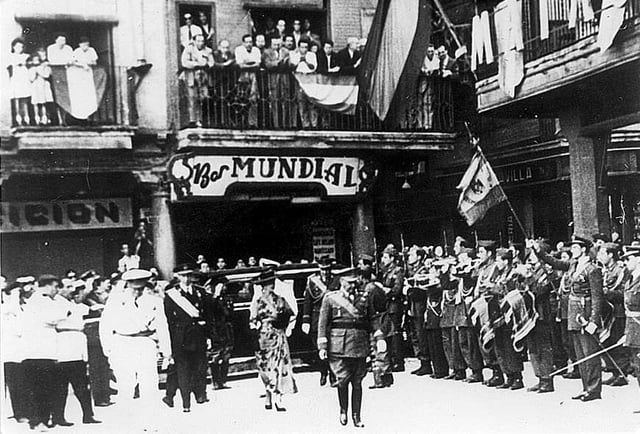
Francisco Franco in Reus, 1940
The defeat of the military rebellion against the Republican government in Barcelona placed Catalonia firmly in the Republican side of the Spanish Civil War. During the war, there were two rival powers in Catalonia: the de jure power of the Generalitat and the de facto power of the armed popular militias.[46] Violent confrontations between the workers' parties (CNT-FAI and POUM against the PSUC) culminated in the defeat of the first ones in 1937. The situation resolved itself progressively in favor of the Generalitat, but at the same time the Generalitat was partially losing its autonomous power within Republican Spain. In 1938 Franco's troops broke the Republican territory in two, isolating Catalonia from the rest of the Republic. The defeat of the Republican army in the Battle of the Ebro led in 1938 and 1939 to the occupation of Catalonia by Franco's forces.
The defeat of the Spanish Republic in the Spanish Civil War brought to power the dictatorship of Francisco Franco, whose first ten-year rule was particularly violent, autocratic, and repressive both in a political, cultural, social, and economical sense.[47] In Catalonia, any kind of public activities associated with Catalan nationalism, republicanism, anarchism, socialism, liberalism, democracy or communism, including the publication of books on those subjects or simply discussion of them in open meetings, was banned.
Franco's regime banned the use of Catalan in government-run institutions and during public events, and also the Catalan institutions of self-government were abolished. The pro-Republic of Spain president of Catalonia, Lluís Companys, was taken to Spain from his exile in the German-occupied France, and was tortured and executed in the Montjuïc Castle of Barcelona for the crime of 'military rebellion'.[48]
During later stages of Francoist Spain, certain folkloric and religious celebrations in Catalan resumed and were tolerated. Use of Catalan in the mass media had been forbidden, but was permitted from the early 1950s[49] in the theatre. Despite the ban during the first years and the difficulties of the next period, publishing in Catalan continued throughout his rule.[50]
The years after the war were extremely hard. Catalonia, like many other parts of Spain, had been devastated by the war. Recovery from the war damage was slow and made more difficult by the international trade embargo and the autarkic politics of Franco's regime. By the late 1950s the region had recovered its pre-war economic levels and in the 1960s was the second fastest growing economy in the world in what became known as the Spanish miracle. During this period there was a spectacular growth of industry and tourism in Catalonia that drew large numbers of workers to the region from across Spain and made the area around Barcelona into one of Europe's largest industrial metropolitan areas.
Transition and democratic period (1975–present)
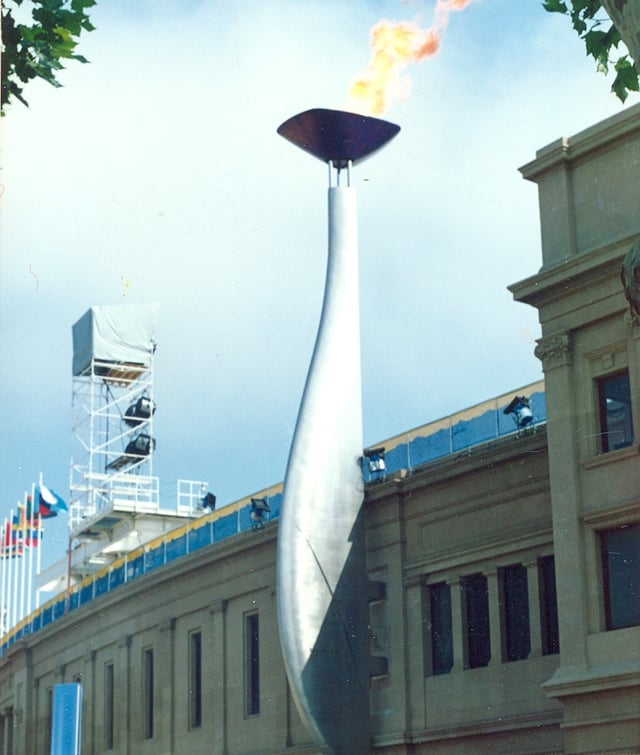
The Olympic flame in the Olympic Stadium Lluís Companys of Barcelona during the 1992 Summer Olympics
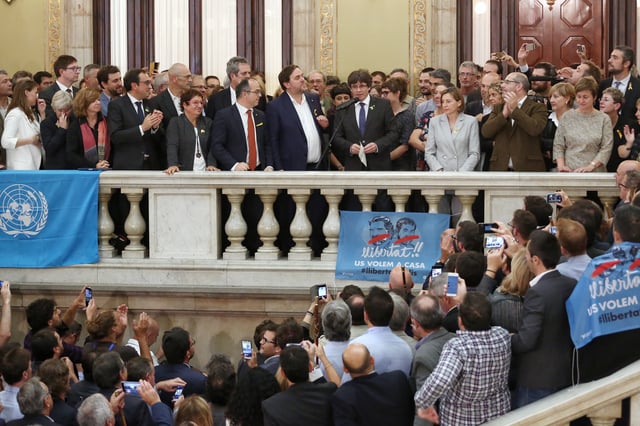
Catalan president, Carles Puigdemont, addresses to the crowd following the unilateral declaration of independence on 27 October
After Franco's death in 1975, Catalonia voted for the adoption of a democratic Spanish Constitution in 1978, in which Catalonia recovered political and cultural autonomy, restoring the Generalitat (exiled since the end of the Civil War in 1939) in 1977 and adopting a new Statute of Autonomy in 1979. First election to the Parliament of Catalonia under this Statute gave the Catalan presidency to Jordi Pujol, a position he would hold until 2003. During this time, he also led Convergència i Unió (CiU), a center-right Catalan nationalist electoral coalition. Throughout the 1980s and 1990s, the institutions of Catalan autonomy continued to develop, among them an autonomous police force (Mossos d'Esquadra, in 1983),[51] and the broadcasting network Televisió de Catalunya and its first channel TV3, created in 1983.[52] Today, Catalonia is one of the most economically dynamic communities of Spain. The Catalan capital and largest city, Barcelona, is a major international cultural centre and a major tourist destination. In 1992, Barcelona hosted the Summer Olympic Games.
In November 2003, elections to the Parliament of Catalonia gave the government to a left-wing catalanist coalition formed by the Socialists' Party of Catalonia (PSC-PSOE), Republican Left of Catalonia (ERC) and Initiative for Catalonia Greens (ICV), and the socialist Pasqual Maragall was appointed President. The new government redacted a new version of the Statute of Autonomy, which consolidated and extended certain aspects of self-government.
The new Statute of Autonomy of Catalonia, approved after a referendum in 2006, was contested by important sectors of the Spanish society, especially by the conservative People's Party, which sent the law to the Constitutional Court of Spain. In 2010, the Court declared non valid some of the articles that established an autonomous Catalan system of Justice, better aspects of the financing, a new territorial division, the status of Catalan language or the symbolical declaration of Catalonia as a nation.[53] This decision was severely contested by large sectors of Catalan society, which increased the demands of independence.[54]
- Independence movement
A controversial independence referendum was held in Catalonia on 1 October 2017, using a disputed voting process.[55][56] It was declared illegal and suspended by the Constitutional Court of Spain, because it breached the 1978 Constitution.[57][58] Subsequent developments saw, on 27 October 2017, a symbolic declaration of independence by the Parliament of Catalonia, the enforcement of direct rule by the Spanish government through the use of Article 155 of the Constitution,[59][60][61][62][63] the dismissal of the Executive Council and the dissolution of the Parliament, with a snap regional election called for 21 December 2017.[64] Former President Carles Puigdemont and five former cabinet ministers fled Spain, whereas nine other cabinet members, including vice-president Oriol Junqueras, were jailed under various charges of rebellion, sedition, and misuse of public funds.[65][66] Quim Torra became the 131st President of the Government of Catalonia on 17 May 2018,[67] after the Spanish courts blocked three other candidates.[68]
In 2018, the Assemblea Nacional Catalana joined the Unrepresented Nations and Peoples Organization (UNPO) on behalf of Catalonia.[69]
Geography
Climate
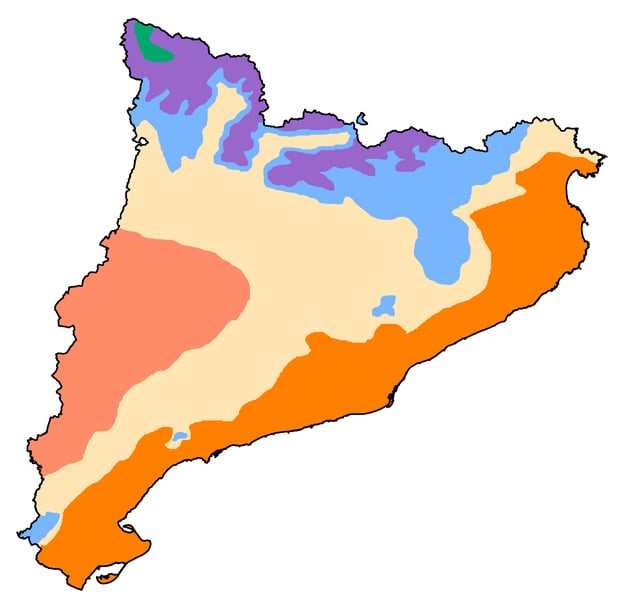
Climates of Catalonia: Oceanic climate Alpine climate Mediterranean climate of alpine influence Inland Mediterranean climate Coastal Mediterranean climate Mediterranean climate of continental influence
The climate of Catalonia is diverse. The populated areas lying by the coast in Tarragona, Barcelona and Girona provinces feature a Hot-summer Mediterranean climate (Köppen Csa). The inland part (including the Lleida province and the inner part of Barcelona province) show a mostly Mediterranean climate (Köppen Csa). The Pyrenean peaks have a continental (Köppen D) or even Alpine climate (Köppen ET) at the highest summits, while the valleys have a maritime or oceanic climate sub-type (Köppen Cfb).
In the Mediterranean area, summers are dry and hot with sea breezes, and the maximum temperature is around 26–31 °C (79–88 °F). Winter is cool or slightly cold depending on the location. It snows frequently in the Pyrenees, and it occasionally snows at lower altitudes, even by the coastline. Spring and autumn are typically the rainiest seasons, except for the Pyrenean valleys, where summer is typically stormy.
The inland part of Catalonia is hotter and drier in summer. Temperature may reach 35 °C (95 °F), some days even 40 °C (104 °F). Nights are cooler there than at the coast, with the temperature of around 14–17 °C (57–63 °F). Fog is not uncommon in valleys and plains; it can be especially persistent, with freezing drizzle episodes and subzero temperatures during winter, mainly along the Ebro and Segre valleys and in Plain of Vic.
Topography
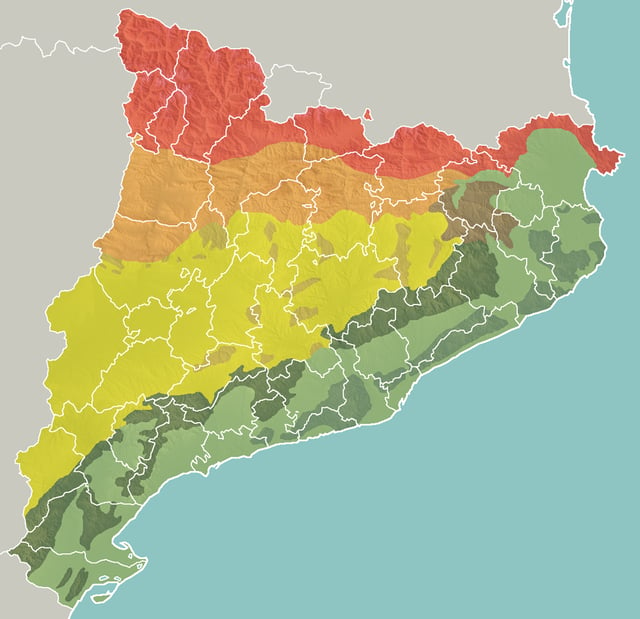
Geomorphologic map of Catalonia: Pyrenees Pre-Pyrenees Catalan Central Depression Smaller mountain ranges of the Central Depression Catalan Transversal Range Catalan Pre-Coastal Range Catalan Coastal Range Catalan Coastal Depression and other coastal and pre-coastal plains
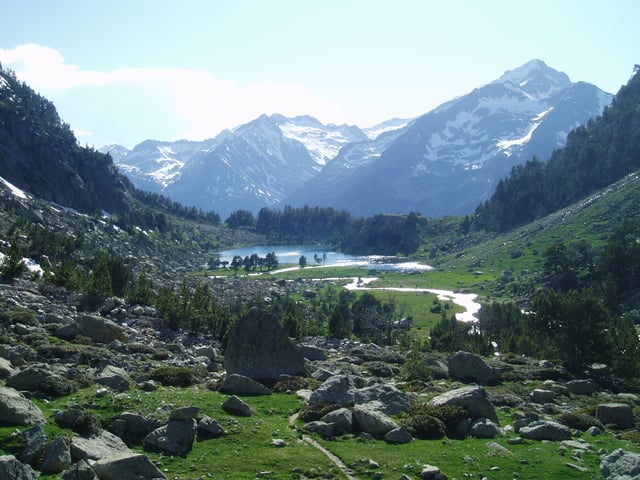
Besiberri in Catalan Pyrenees
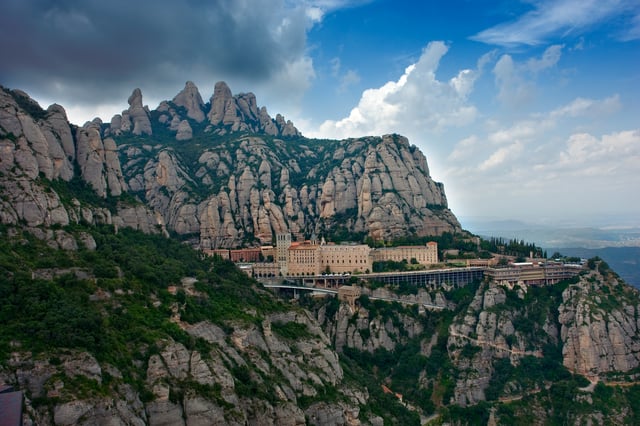
Mountain of Montserrat and the monastery
Catalonia has a marked geographical diversity, considering the relatively small size of its territory. The geography is conditioned by the Mediterranean coast, with 580 kilometres (360 miles) of coastline, and large relief units of the Pyrenees to the north. The Catalan territory is divided into three main geomorphological units:[70]
The Pyrenees: mountainous formation that connects the Iberian Peninsula with the European continental territory, and located in the north of Catalonia;
The Catalan Coastal mountain ranges or the Catalan Mediterranean System: an alternating delevacions and planes parallel to the Mediterranean coast;
The Catalan Central Depression: structural unit which forms the eastern sector of the Valley of the Ebro.
The Catalan Pyrenees represent almost half in length of the Pyrenees, as it extends more than 200 kilometres (120 miles). Traditionally differentiated the Axial Pyrenees (the main part) and the Pre-Pyrenees (southern from the Axial) which are mountainous formations parallel to the main mountain ranges but with lower altitudes, less steep and a different geological formation. The highest mountain of Catalonia, located north of the comarca of Pallars Sobirà is the Pica d'Estats (3,143 m), followed by the Puigpedrós (2,914 m). On the Pre-Pyrenees is located the Serra del Cadí, that separates the valley of Cerdanya from the Central Depression.
Central Catalan Depression is a plain located between the Pyrenees and Pre-Coastal Mountains. The Depression lands are located between 200 and 600 metres (660 and 1,970 feet). The plains and the water that descend from the Pyrenees have made it fertile territory for agriculture and there are built numerous irrigation canals. Other important plain is the Empordà, located on the northeast.
The Catalan Mediterranean system is based on two (more or less) parallel ranges to the coast, in a Northwest direction towards the Southwest. These two mountain ranges are the Coastal and the Pre-Coastal. The Coastal Range is minor extent and it has lower altitudes, while the Pre-Coastal is larger in both length and height. The most relevant mountains of this area are Montserrat, Montseny and Ports. Within the ranges are a series of plains, the entities over which form the Coastal and the Pre-Coastal Depressions. The Coastal Depression is located on the East of the Coastal Range towards the coast. The Pre-Coastal, on the other hand, is located in the interior, between the two mountain ranges, and constitutes the basis of the plains of Vallès and Penedès.
Flora and fauna
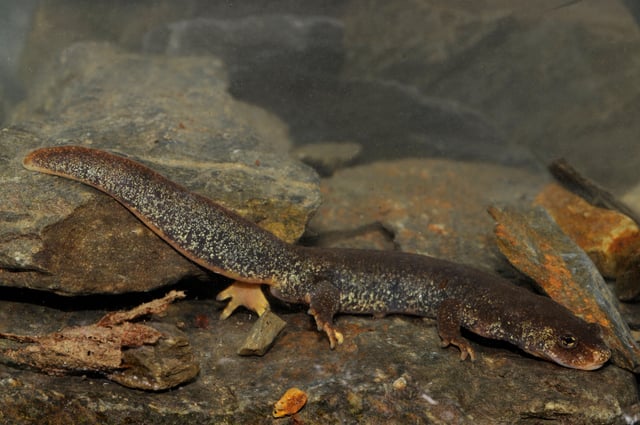
Montseny brook newt (Calotriton arnoldi), endemic to the Montseny Massif
Catalonia is a showcase of European landscapes on a small scale. Just over 30,000 square kilometres (12,000 square miles) hosting a variety of substrates, soils, climates, directions, altitudes and distances to the sea. The area is of great ecological diversity and a remarkable wealth of landscapes, habitats and species.
The fauna of Catalonia comprises a minority of animals endemic to the region and a majority of non-native animals. Much of Catalonia enjoys a Mediterranean climate (except mountain areas), which makes many of the animals that live there adapted to Mediterranean ecosystems. Of mammals, there are plentiful wild boar, red foxes, as well as roe deer and in the Pyrenees, the Pyrenean chamois. Other large species such as the bear have been recently reintroduced.
Hydrography
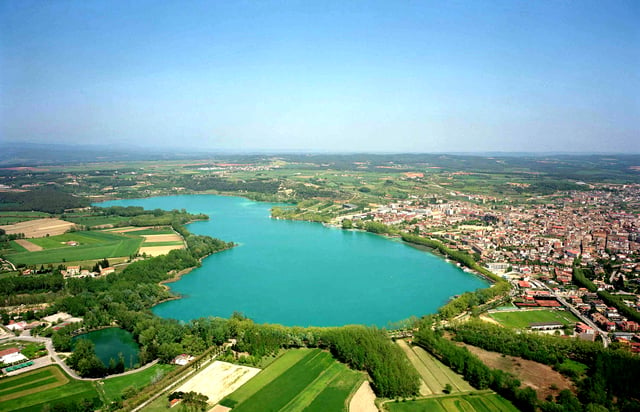
Lake of Banyoles
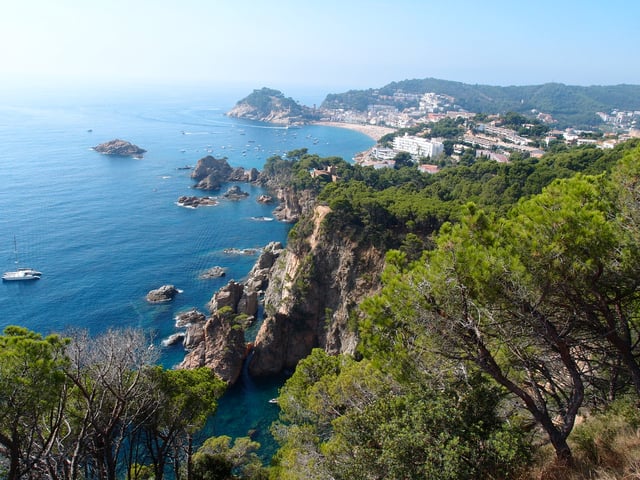
Tossa de Mar, Costa Brava
Most of Catalonia belongs to the Mediterranean Basin. The Catalan hydrographic network consists of two important basins, the one of the Ebro and the one that comprises the internal basins of Catalonia (respectively covering 46.84% and 51.43% of the territory), all of them flow to the Mediterranean. Furthermore, there is the Garona river basin that flows to the Atlantic Ocean, but it only covers 1.73% of the Catalan territory.
The hydrographic network can be divided in two sectors, an occidental slope or Ebro river slope and one oriental slope constituted by minor rivers that flow to the Mediterranean along the Catalan coast. The first slope provides an average of 18,700 cubic hectometres (4.5 cubic miles) per year, while the second only provides an average of 2,020 hm3 (0.48 cu mi)/year. The difference is due to the big contribution of the Ebro river, from which the Segre is an important tributary. Moreover, in Catalonia there is a relative wealth of groundwaters, although there is inequality between comarques, given the complex geological structure of the territory.[73] In the Pyrenees there are many small lakes, remnants of the ice age. The biggest are the lake of Banyoles and the recently recovered lake of Ivars.
The Catalan coast is almost rectilinear, with a length of 580 kilometres (360 mi) and few landforms—the most relevant are the Cap de Creus and the Gulf of Roses to the north and the Ebro Delta to the south. The Catalan Coastal Range hugs the coastline, and it is split into two segments, one between L'Estartit and the town of Blanes (the Costa Brava), and the other at the south, at the Costes del Garraf.
The principal rivers in Catalonia are the Ter, Llobregat, and the Ebro (Catalan: Ebre), all of which run into the Mediterranean.
Anthropic pressure and protection of nature
The majority of Catalan population is concentrated in 30% of the territory, mainly in the coastal plains. Intensive agriculture, livestock farming and industrial activities have been accompanied by a massive tourist influx (more than 20 million annual visitors), a rate of urbanization and even of major metropolisation which has led to a strong urban sprawl: a third of Catalans live in the urban area of Barcelona, while the proportion of urbanized soils increased from 4.2% in 1993 to 6.2% in 2009, a growth of 48.6% in sixteen years, complemented with a dense network of transport infrastructure. This is accompanied by a certain agricultural abandonment (decrease of 15% of all areas cultivated in Catalonia between 1993 and 2009) and a global threat to natural environment. Human activities have also put some animal species at risk, or even led to their disappearance from the territory, like the gray wolf and probably the brown bear of the Pyrenees. The pressure created by this model of life means that the country's ecological footprint exceeds its administrative area.[74]
Faced with this problems, Catalan authorities initiated several measures whose purpose is to protect natural ecosystems. Thus, in 1990, the Catalan government created the Nature Conservation Council (Catalan: Consell de Protecció de la Natura), an advisory body with the aim to study, protect and manage the natural environments and landscapes of Catalonia. In addition, the Generalitat has carried out the Plan of Spaces of Natural Interest (Pla d'Espais d'Interès Natural or PEIN) in 1992 while eighteen Natural Spaces of Special Protection (Espais Naturals de Protecció Especial or ENPE) have been instituted.
There's a National Park, Aigüestortes i Estany de Sant Maurici; fourteen Natural Parks, Alt Pirineu, Aiguamolls de l'Empordà, Cadí-Moixeró, Cap de Creus, Sources of Ter and Freser, Collserola, Ebro Delta, Ports, Montgrí, Medes Islands and Baix Ter, Montseny, Montserrat, Sant Llorenç del Munt and l'Obac, Serra de Montsant and the Garrotxa Volcanic Zone; as well as three Natural Places of National Interest (Paratge Natural d'Interes Nacional or PNIN), the Pedraforca, the Poblet Forest and the Albères.
Politics
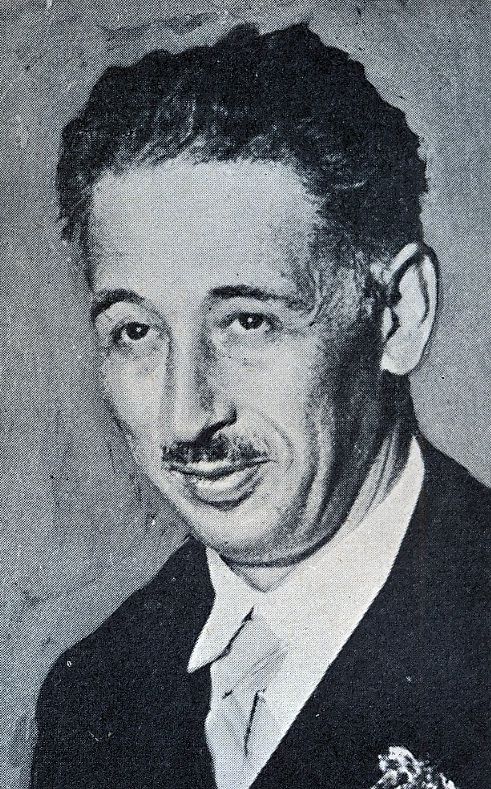
Lluís Companys, second president of the Generalitat of Catalonia between 1933 and 1940, executed by Franco's regime
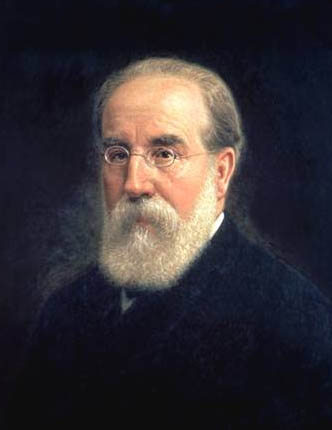
Francesc Pi i Margall(president of the First Spanish Republic)
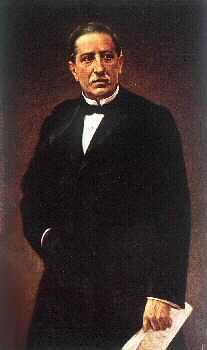
Estanislao Figueras (president of the First Spanish Republic)
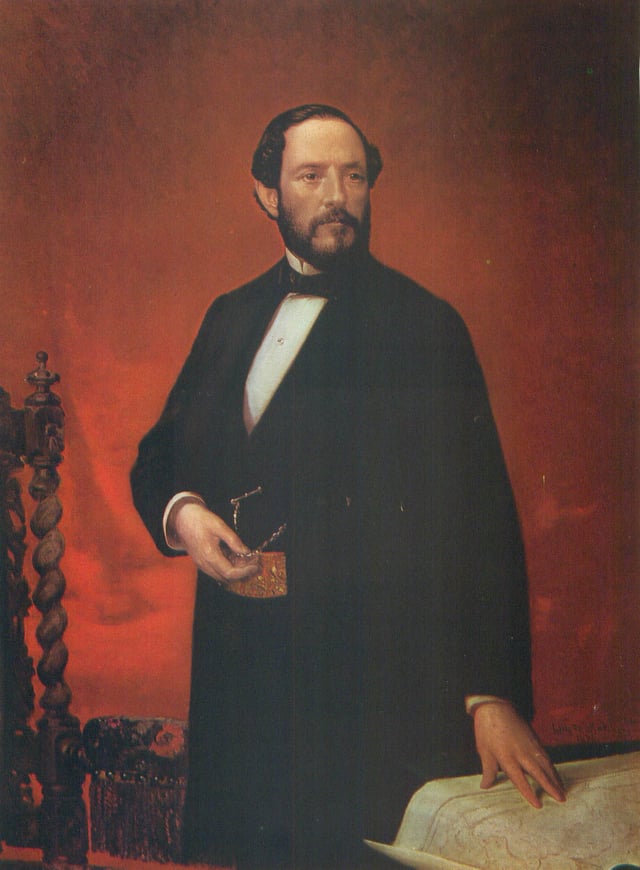
Juan Prim (Spanish prime minister under regent don Francisco Serrano)
After Franco's death in 1975 and the adoption of a democratic constitution in Spain in 1978, Catalonia recovered and extended the powers that it had gained in the Statute of Autonomy of 1932[75] but lost with the fall of the Second Spanish Republic[76] at the end of the Spanish Civil War in 1939.
This autonomous community has gradually achieved more autonomy since the approval of the Spanish Constitution of 1978. The Generalitat holds exclusive jurisdiction in education, health, culture, environment, communications, transportation, commerce, public safety and local government, and only shares jurisdiction with the Spanish government in justice.[77] In all, some analysts argue that formally the current system grants Catalonia with "more self-government than almost any other corner in Europe".[78]
The support for Catalan nationalism ranges from a demand for further autonomy and the federalisation of Spain to the desire for independence from the rest of Spain, expressed by Catalan independentists.[79] The first survey following the Constitutional Court ruling that cut back elements of the 2006 Statute of Autonomy, published by La Vanguardia on 18 July 2010, found that 46% of the voters would support independence in a referendum.[80] In February of the same year, a poll by the Open University of Catalonia gave more or less the same results.[81] Other polls have shown lower support for independence, ranging from 40 to 49%.[82][83][84] Although it is established in the whole of the territory, support for independence is significantly higher in the hinterland and the northeast, away from the more populated coastal areas such as Barcelona.[85]
Since 2011 when the question started to be regularly surveyed by the governmental Center for Public Opinion Studies (CEO), support for Catalan independence has been on the rise.[86] According to the CEO opinion poll from July 2016, 47.7% of Catalans would vote for independence and 42.4% against it while, about the question of preferences, according to the CEO opinion poll from March 2016, a 57.2 claim to be "absolutely" or "fairly" in favour of independence.[87][88] Other polls have shown lower support for independence, ranging from 40 to 49%.[82][83][84] Other polls show more variable results, according with the Spanish CIS, as of December 2016, 47% of Catalans rejected independence and 45% supported it.[89]
In hundreds of non-binding local referendums on independence, organised across Catalonia from 13 September 2009, a large majority voted for independence, although critics argued that the polls were mostly held in pro-independence areas. In December 2009, 94% of those voting backed independence from Spain, on a turn-out of 25%.[90] The final local referendum was held in Barcelona, in April 2011. On 11 September 2012, a pro-independence march pulled in a crowd of between 600,000 (according to the Spanish Government), 1.5 million (according to the Guàrdia Urbana de Barcelona), and 2 million (according to its promoters);[91][92] whereas poll results revealed that half the population of Catalonia supported secession from Spain.
Two major factors were Spain's Constitutional Court's 2010 decision to declare part of the 2006 Statute of Autonomy of Catalonia unconstitutional, as well as the fact that Catalonia contributes 19.49% of the central government's tax revenue, but only receives 14.03% of central government's spending.[93]
Parties that consider themselves either Catalan nationalist or independentist have been present in all Catalan governments since 1980. The largest Catalan nationalist party, Convergence and Union, ruled Catalonia from 1980 to 2003, and returned to power in the 2010 election. Between 2003 and 2010, a leftist coalition, composed by the Catalan Socialists' Party, the pro-independence Republican Left of Catalonia and the leftist-environmentalist Initiative for Catalonia-Greens, implemented policies that widened Catalan autonomy.[94]
In the 25 November 2012 Catalan parliamentary election, sovereigntist parties supporting a secession referendum gathered 59.01% of the votes and held 87 of the 135 seats in the Catalan Parliament. Parties supporting independence from the rest of Spain obtained 49.12% of the votes and a majority of 74 seats.
Artur Mas, then the president of Catalonia, organised early elections that took place on 27 September 2015. In these elections, Convergència and Esquerra Republicana decided to join, and they presented themselves under the coalition named "Junts pel Sí" (in Catalan, "Together for Yes"). "Junts pel Sí" won 62 seats and was the most voted party, and CUP (Candidatura d'Unitat Popular, a far-left and independentist party) won another 10, so the sum of all the independentist forces/parties was 72 seats, reaching an absolute majority, but not in number of individual votes, comprising 47,74% of the total.[95]
Statute of Autonomy
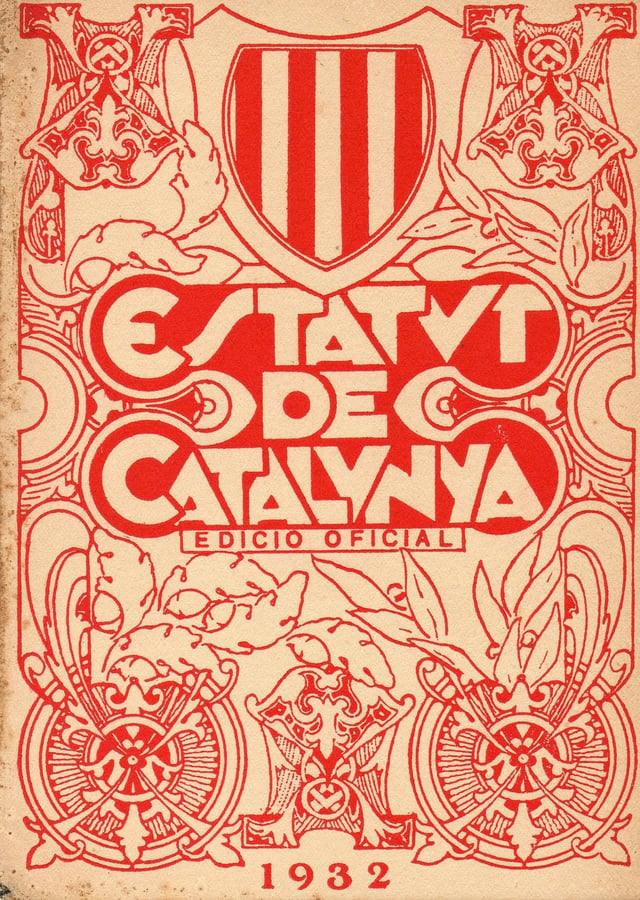
The first Statute of Catalonia, 1932
The Statute of Autonomy of Catalonia is the fundamental organic law, second only to the Spanish Constitution from which the Statute originates.
In the Spanish Constitution of 1978 Catalonia, along with the Basque Country and Galicia, was defined as a "nationality". The same constitution gave Catalonia the automatic right to autonomy, which resulted in the Statute of Autonomy of Catalonia of 1979.
Both the 1979 Statute of Autonomy and the current one, approved in 2006, state that "Catalonia, as a nationality, exercises its self-government constituted as an Autonomous Community in accordance with the Constitution and with the Statute of Autonomy of Catalonia, which is its basic institutional law, always under the law in Spain".[96]
The Preamble of the 2006 Statute of Autonomy of Catalonia states that the Parliament of Catalonia has defined Catalonia as a nation, but that "the Spanish Constitution recognizes Catalonia's national reality as a nationality".[97] While the Statute was approved by and sanctioned by both the Catalan and Spanish parliaments, and later by referendum in Catalonia, it has been subject to a legal challenge by the surrounding autonomous communities of Aragon, Balearic Islands and Valencia,[98] as well as by the conservative People's Party. The objections are based on various issues such as disputed cultural heritage but, especially, on the Statute's alleged breaches of the principle of "solidarity between regions" in fiscal and educational matters enshrined by the Constitution.[99]
Spain's Constitutional Court assessed the disputed articles and on 28 June 2010, issued its judgment on the principal allegation of unconstitutionality presented by the People's Party in 2006. The judgment granted clear passage to 182 articles of the 223 that make up the fundamental text. The court approved 73 of the 114 articles that the People's Party had contested, while declaring 14 articles unconstitutional in whole or in part and imposing a restrictive interpretation on 27 others.[100] The court accepted the specific provision that described Catalonia as a "nation", however ruled that it was a historical and cultural term with no legal weight, and that Spain remained the only nation recognised by the constitution.[101][102][103][104]
Government and law
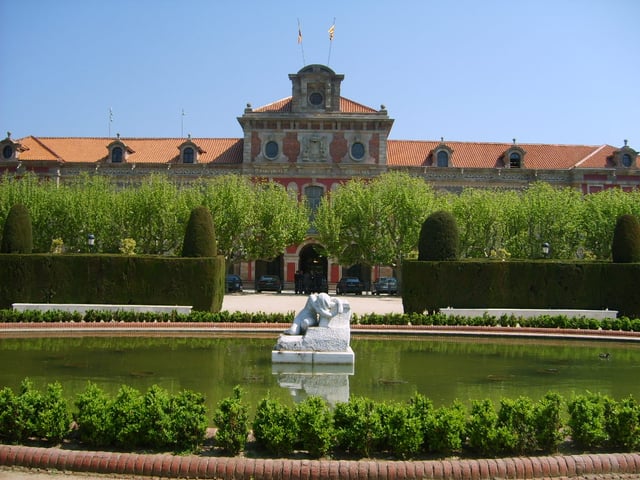
Parliament of Catalonia, located in Ciutadella park, Barcelona
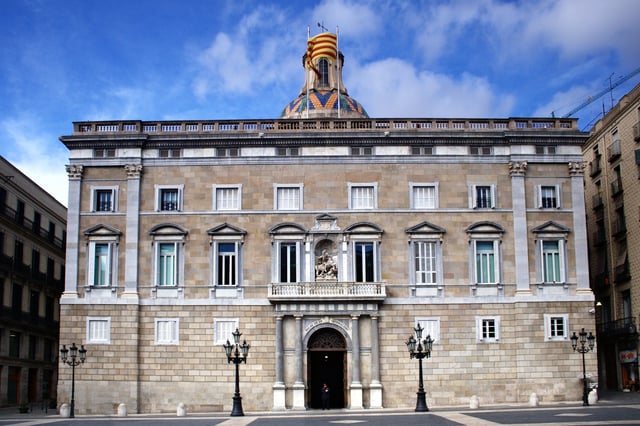
Palau de la Generalitat de Catalunya, Barcelona, seat of the Government and the Presidency of Catalonia
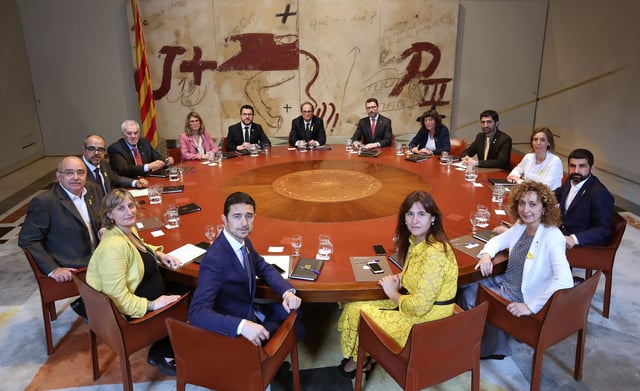
Government of Catalonia (2018–). Quim Torra, President of the Generalitat, is in the background, at the center; Pere Aragonès, the Vice-president, on his right from his point of view
The Catalan Statute of Autonomy establishes that Catalonia is organised politically through the Generalitat of Catalonia (in Catalan: Generalitat de Catalunya), conformed by the Parliament, the Presidency of the Generalitat, the Government or Executive Council and the other institutions created by the Parliament, among them the Ombudsman (Síndic de Greuges), the Office of Auditors (Sindicatura de Comptes) or the Council for Statutory Guarantees (Consell de Garanties Estatutàries)
Legislature
The Parliament of Catalonia (in Catalan: Parlament de Catalunya) is the legislative body of the Generalitat and represents the citizens of Catalonia. It is elected every four years by universal suffrage, and it has powers to legislate in different matters such as education, health, culture, internal institutional and territorial organization, election and control of the president of the Generalitat and the Government, budget and other affairs, according with the Statute of Autonomy. The last Catalan election was held on 21 December 2017, and its current president is Roger Torrent, incumbent since January 2018.
Presidency
The president of the Generalitat of Catalonia (in Catalan: president de la Generalitat de Catalunya) is the highest representative of Catalonia, and is also responsible of leading the government's action. Since the restoration of the Generalitat on the return of democracy in Spain, the presidents of Catalonia have been Josep Tarradellas (1977–1980, president in exile since 1954), Jordi Pujol (1980–2003), Pasqual Maragall (2003–2006), José Montilla (2006–2010), Artur Mas (2010–2016), Carles Puigdemont (2016–2017) and, after the imposition of direct rule from Madrid, Quim Torra (2018–).
Executive
The Executive Council (in Catalan: Consell Executiu) or Government (Govern), is the body responsible of the government of the Generalitat, it holds executive and regulatory power. It comprises the president of the Generalitat, the First Minister (or the Vice President) and the Ministers (consellers). Its seat is the Palau de la Generalitat, in Barcelona.
Security forces and Justice
Catalonia has its own police force, the Mossos d'Esquadra (officially called Mossos d'Esquadra-Policia de la Generalitat de Catalunya), whose origins date back to the 18th century. Since 1980 they have been under the command of the Generalitat, and since 1994 they have expanded in number in order to replace the national Civil Guard and National Police Corps, which report directly to the Homeland Department of Spain. The national bodies retain personnel within Catalonia to exercise functions of national scope such as overseeing ports, airports, coasts, international borders, custom offices, the identification of documents and arms control, immigration control, terrorism prevention, arms trafficking prevention, amongst others.
Most of the justice system is administered by national judicial institutions, the highest body and last judicial instance in the Catalan jurisdiction, integrating the Spanish judiciary, is the High Court of Justice of Catalonia. The criminal justice system is uniform throughout Spain, while civil law is administered separately within Catalonia. The civil laws that are subject to autonomous legislation have been codified in the Civil Code of Catalonia (Codi civil de Catalunya) since 2002.[105]
Navarre, the Basque Country and Catalonia are the Spanish communities with the highest degree of autonomy in terms of law enforcement.
Administrative divisions

Administrative divisions of Catalonia
Catalonia is organised territorially into provinces, further subdivided into comarques and municipalities. The 2006 Statute of Autonomy of Catalonia establishes the administrative organisation of three local authorities: vegueries, comarques, and municipalities.
Provinces
Catalonia is divided administratively into four provinces, the governing body of which is the Provincial Deputation (Catalan: Diputació Provincial, Spanish: Diputación Provincial). The four provinces and their populations are:[106]
Province of Barcelona: 5,507,813 population
Province of Girona: 752,026 population
Province of Lleida: 439,253 population
Province of Tarragona: 805,789 population
Comarques
Comarques (singular: "comarca") are entities composed by the municipalities to manage their responsibilities and services. The current regional division has its roots in a decree of the Generalitat de Catalunya of 1936, in effect until 1939, when it was suppressed by Franco. In 1987 the Government adopted the territorial division again and in 1988 three new comarques were added (Alta Ribagorça, Pla d'Urgell and Pla de l'Estany), and in 2015 was created another comarca, the Moianès. At present there are 41. Every comarca is administered by a comarcal council (consell comarcal).
The Val d'Aran (Aran Valley), until 2015 considered as a comarca, is officially defined today as "unique territorial entity", has a special status and its autonomous government is named Conselh Generau d'Aran.[107]
Municipalities
There are at present 948 municipalities (municipis) in Catalonia. Each municipality is run by a council (ajuntament) elected every four years by the residents in local elections. The council consists of a number of members (regidors) depending on population, who elect the mayor (alcalde or batlle). Its seat is the town hall (ajuntament, casa de la ciutat or casa de la vila).
Vegueries
The vegueria is a new type of division defined as a specific territorial area for the exercise of government and inter-local cooperation with legal personality. The current Statute of Autonomy states vegueries are intended to supersede provinces in Catalonia, and take over many of functions of the comarques.
The territorial plan of Catalonia (Pla territorial general de Catalunya) provided six general functional areas,[108] but was amended by Law 24/2001, of 31 December, recognizing the Alt Pirineu i Aran as a new functional area differentiated of Ponent.[109] On 14 July 2010 the Catalan Parliament approved the creation of the functional area of the Penedès.[110]
Alt Pirineu i Aran: Alta Ribagorça, Alt Urgell, Cerdanya, Pallars Jussà, Pallars Sobirà and Val d'Aran.
Àmbit Metropolità de Barcelona: Baix Llobregat, Barcelonès, Garraf, Maresme, Vallès Oriental and Vallès Occidental.
Camp de Tarragona: Tarragonès, Alt Camp, Baix Camp, Conca de Barberà and Priorat.
Comarques gironines: Alt Empordà, Baix Empordà, Garrotxa, Gironès, Pla de l'Estany, La Selva and Ripollès.
Comarques centrals: Anoia (8 municipalities of 33), Bages, Berguedà, Osona and Solsonès.
Penedès: Alt Penedès, Baix Penedès, Anoia (25 municipalities of 33) and Garraf.
Ponent: Garrigues, Noguera, Segarra, Segrià, Pla d'Urgell and Urgell.
Terres de l'Ebre: Baix Ebre, Montsià, Ribera d'Ebre and Terra Alta.
Economy
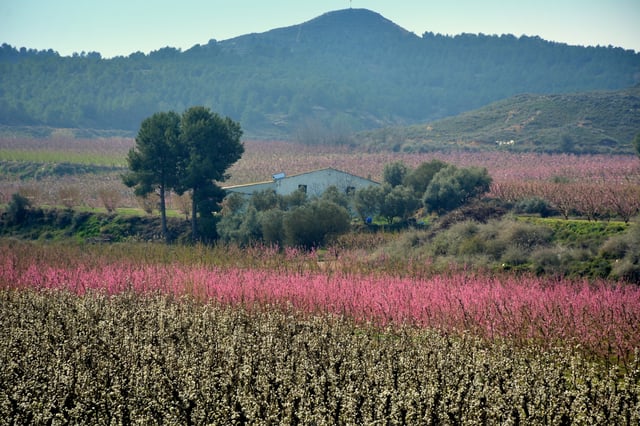
Peach fields in Aitona
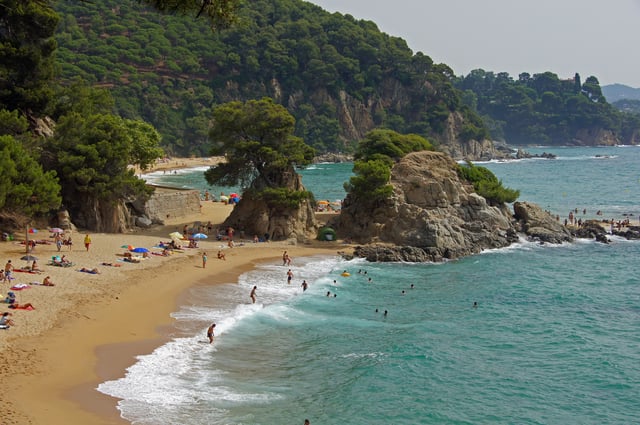
Costa Brava beach. Tourism plays an important role in the Catalan economy.
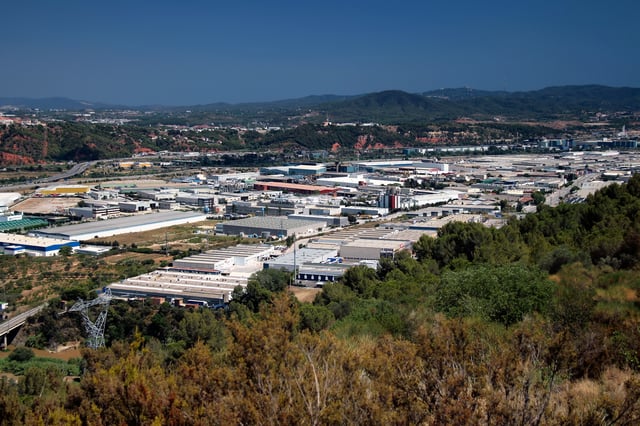
Industrial park in Castellbisbal

Factories, La Pobla de Mafumet, Tarragona
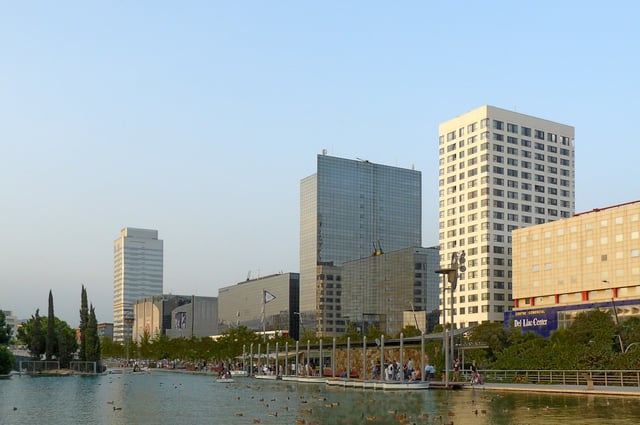
Eix Macià, Sabadell
A highly industrialized land, the nominal GDP of Catalonia in 2014 was €200 billion (usually the highest in Spain) and the per capita GDP was €27,000 ($30,000), behind Madrid (€31,000), the Basque Country (€30,000), and Navarre (€28,000).[111] In that year, the GDP growth was 1.4%.[111] In recent years there has been a negative net relocation rate of companies based in Catalonia moving to other autonomous communities of Spain. In 2014, for example, Catalonia lost 987 companies to other parts of Spain (mainly Madrid), gaining 602 new ones from the rest of the country.[112]
Catalonia's long-term credit rating is BB (Non-Investment Grade) according to Standard & Poor's, Ba2 (Non-Investment Grade) according to Moody's, and BBB- (Low Investment Grade) according to Fitch Ratings.[113][114][115] Catalonia's rating is tied for worst with between 1 and 5 other autonomous communities of Spain, depending on the rating agency.[115]
In the context of the financial crisis of 2007–2008, Catalonia was expected to suffer a recession amounting to almost a 2% contraction of its regional GDP in 2009.[116] Catalonia's debt in 2012 was the highest of all Spain's autonomous communities,[117] reaching €13,476 million, i.e. 38% of the total debt of the 17 autonomous communities,[118] but in recent years its economy recovered a positive evolution and the GDP grew a 3.3% in 2015.[119]
Catalonia is amongst the List of country subdivisions by GDP over 100 billion US dollars and is a member of the Four Motors for Europe organisation.
The distribution of sectors is as follows:[120]
Primary sector: 3%. The amount of land devoted to agricultural use is 33%.
Secondary sector: 37% (compared to Spain's 29%)
Tertiary sector: 60% (compared to Spain's 67%)
The main tourist destinations in Catalonia are the city of Barcelona, the beaches of the Costa Brava in Girona, the beaches of the Costa del Maresme and Costa del Garraf from Malgrat de Mar to Vilanova i la Geltrú and the Costa Daurada in Tarragona. In the High Pyrenees there are several ski resorts, near Lleida. On 1 November 2012, Catalonia started charging a tourist tax.[121] The revenue is used to promote tourism, and to maintain and upgrade tourism-related infrastructure.
The stock market of Barcelona, which in 2016 had a volume of around €152 billion, is the second largest of Spain after Madrid, and Fira de Barcelona organizes international exhibitions and congresses to do with different sectors of the economy.[124]
The main economic cost for the Catalan families is the purchase of a home. According to data from the Society of Appraisal on 31 December 2005 Catalonia is, after Madrid, the second most expensive region in Spain for housing: 3,397 €/m2 on average (see Spanish property bubble).
Unemployment
The unemployment rate stood at 11.5% in 2018 and was lower than the national average.[125]
| 2006 | 2007 | 2008 | 2009 | 2010 | 2011 | 2012 | 2013 | 2014 | 2015 | 2016 | 2017 | 2018 |
|---|---|---|---|---|---|---|---|---|---|---|---|---|
| 6.5% | 6.5% | 8.9% | 16.2% | 17.7% | 19.2% | 22.5% | 23.1% | 20.3% | 18.6% | 15.7% | 13.4% | 11.5% |
Transport
Airports
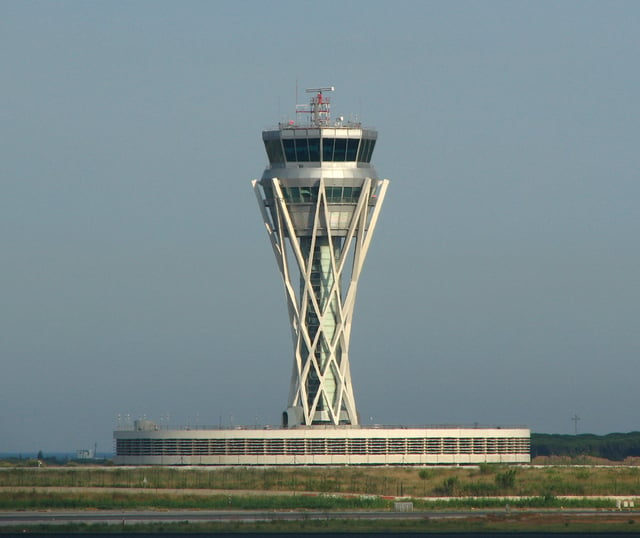
Barcelona Airport tower
Airports in Catalonia are owned and operated by Aena (a Spanish Government entity) except two airports in Lleida which are operated by Aeroports de Catalunya (an entity belonging to the Government of Catalonia).
Barcelona El Prat Airport (Aena)
Girona-Costa Brava Airport (Aena)
Reus Airport (Aena)
Lleida-Alguaire Airport (Aeroports de Catalunya)
Sabadell Airport (Aena)
La Seu d'Urgell Airport (Aeroports de Catalunya)
Ports
Since the Middle Ages, Catalonia has been well integrated into international maritime networks. The port of Barcelona (owned and operated by Puertos del Estado, a Spanish Government entity) is an industrial, commercial and tourist port of worldwide importance. With 1,950,000 TEUs in 2015, it is the first container port in Catalonia, the third in Spain after Valencia and Algeciras in Andalusia, the 9th in the Mediterranean Sea, the 14th in Europe and the 68th in the world. It is sixth largest cruise port in the world, the first in Europe and the Mediterranean with 2,364,292 passengers in 2014. The ports of Tarragona (owned and operated by Puertos del Estado) in the southwest and Palamós near Girona at northeast are much more modest. The port of Palamós and the other ports in Catalonia (26) are operated and administered by Ports de la Generalitat, a Catalan Government entity.
The development of these infrastructures, resulting from the topography and history of the Catalan territory, responds strongly to the administrative and political organization of this autonomous community.
Roads
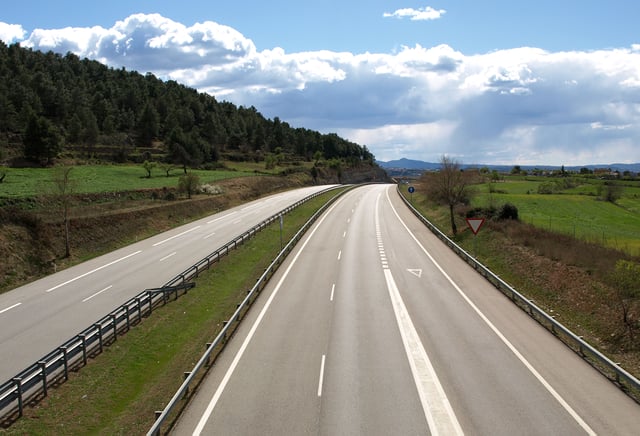
Autovia C-16 (Eix del Llobregat)
There are 12,000 kilometres (7,500 mi) of roads throughout Catalonia.
The principal highways are
AP-7 [[INLINE_IMAGE|//upload.wikimedia.org/wikipedia/commons/thumb/e/e4/Spain_traffic_signal_r200.svg/16px-Spain_traffic_signal_r200.svg.png|//upload.wikimedia.org/wikipedia/commons/thumb/e/e4/Spain_traffic_signal_r200.svg/24px-Spain_traffic_signal_r200.svg.png 1.5x, //upload.wikimedia.org/wikipedia/commons/thumb/e/e4/Spain_traffic_signal_r200.svg/32px-Spain_traffic_signal_r200.svg.png 2x|Spain traffic signal r200.svg|h16|w16]] (Autopista de la Mediterrània) and
A-7 (Autovia de la Mediterrània). They follow the coast from the French border to Valencia, Murcia and Andalusia. The main roads generally radiate from Barcelona. The
AP-2 [[INLINE_IMAGE|//upload.wikimedia.org/wikipedia/commons/thumb/e/e4/Spain_traffic_signal_r200.svg/16px-Spain_traffic_signal_r200.svg.png|//upload.wikimedia.org/wikipedia/commons/thumb/e/e4/Spain_traffic_signal_r200.svg/24px-Spain_traffic_signal_r200.svg.png 1.5x, //upload.wikimedia.org/wikipedia/commons/thumb/e/e4/Spain_traffic_signal_r200.svg/32px-Spain_traffic_signal_r200.svg.png 2x|Spain traffic signal r200.svg|h16|w16]] (Autopista del Nord-est) and
A-2 (Autovia del Nord-est) connect inland and onward to Madrid.
Other major roads are:
Public-own roads in Catalonia are either managed by the autonomous government of Catalonia (e.g.,
C- roads) or the Spanish government (e.g.,
AP- ,
A- ,
N- roads).
Railways

High-speed train (AVE) at Camp de Tarragona
Catalonia saw the first railway construction in the Iberian Peninsula in 1848, linking Barcelona with Mataró. Given the topography most lines radiate from Barcelona. The city has both suburban and inter-city services. The main east coast line runs through the province connecting with the SNCF (French Railways) at Portbou on the coast.
There are two publicly owned railway companies operating in Catalonia: the Catalan FGC that operates commuter and regional services, and the Spanish national RENFE that operates long-distance and high-speed rail services (AVE and Avant) and the main commuter and regional service Rodalies de Catalunya, administered by the Catalan government since 2010.
High-speed rail (AVE) services from Madrid currently reach Lleida, Tarragona and Barcelona. The official opening between Barcelona and Madrid took place 20 February 2008. The journey between Barcelona and Madrid now takes about two-and-a-half hours. A connection to the French high-speed TGV network has been completed (called the Perpignan–Barcelona high-speed rail line) and the Spanish AVE service began commercial services on the line 9 January 2013, later offering services to Marseille on their high speed network.[126][127] This was shortly followed by the commencement of commercial service by the French TGV on 17 January 2013, leading to an average travel time on the Paris-Barcelona TGV route of 7h 42m.[127][128] This new line passes through Girona and Figueres with a tunnel through the Pyrenees.
Demographics
| Historical population | ||
|---|---|---|
| Year | Pop. | ±% |
| 1900 | 1,966,382 | — |
| 1910 | 2,084,868 | +6.0% |
| 1920 | 2,344,719 | +12.5% |
| 1930 | 2,791,292 | +19.0% |
| 1940 | 2,890,974 | +3.6% |
| 1950 | 3,240,313 | +12.1% |
| 1960 | 3,925,779 | +21.2% |
| 1970 | 5,122,567 | +30.5% |
| 1981 | 5,949,829 | +16.1% |
| 1990 | 6,062,273 | +1.9% |
| 2000 | 6,174,547 | +1.9% |
| 2010 | 7,462,044 | +20.9% |
| 2017 | 7,441,176 | −0.3% |
| Source: INE | ||
The Urban Region of Barcelona includes 5,217,864 people and covers an area of 2,268 km2 (876 sq mi). The metropolitan area of the Urban Region includes cities such as L'Hospitalet de Llobregat, Sabadell, Terrassa, Badalona, Santa Coloma de Gramenet and Cornellà de Llobregat.
In 1900, the population of Catalonia was 1,966,382 people and in 1970 it was 5,122,567.[129] The sizeable increase of the population was due to the demographic boom in Spain during the 60s and early 70s[131] as well as in consequence of large-scale internal migration from the rural economically weak regions to its more prospering industrial cities. In Catalonia that wave of internal migration arrived from several regions of Spain, especially from Andalusia, Murcia[132] and Extremadura.[133]
Immigrants from other countries settled in Catalonia since the 1990s;[134] a large percentage comes from Africa, Latin America and Eastern Europe, and smaller numbers from Asia and Southern Europe, often settling in urban centers such as Barcelona and industrial areas.[135] In 2017, Catalonia had 1,194,497 foreign residents (15.9% of the total population) with non-Spanish ID cards, without including those who acquired the Spanish citizenship.[136]
Religion
Historically, all the Catalan population was Christian, specifically Catholic, but since the 1980s there has been a trend of decline of Christianity and parallel growth of irreligion (including stances of atheism and agnosticism) and other religions. According to the most recent study sponsored by the government of Catalonia, as of 2016, 61.9% of the Catalans identify as Christians, up from 56.5% in 2014,[139] of whom 58.0% Catholics, 3.0% Protestants and Evangelicals, 0.9% Orthodox Christians and 0.6% Jehovah's Witnesses. At the same time, 16.0% of the population identify as atheists, 11.9% as agnostics, 4.8% as Muslims, 1.3% as Buddhists, and a further 2.4% as being of other religions.[138]
Languages

Catalan-speaking regions of Europe
According to the linguistic census held by the Government of Catalonia in 2013, Spanish is the most spoken language in Catalonia (46.53% claim Spanish as "their own language"), followed by Catalan (37.26% claim Catalan as "their own language"). In everyday use, 11.95% of the population claim to use both languages equally, whereas 45.92% mainly use Spanish and 35.54% mainly use Catalan. There is a significant difference between the Barcelona metropolitan area (and, to a lesser extent, the Tarragona area), where Spanish is more spoken than Catalan, and the more rural and small town areas, where Catalan clearly prevails over Spanish.[140]
Originating in the historic territory of Catalonia, Catalan has enjoyed special status since the approval of the Statute of Autonomy of 1979 which declares it to be "Catalonia's own language",[141] a term which signifies a language given special legal status within a Spanish territory, or which is historically spoken within a given region. The other languages with official status are Spanish, which has official status throughout Spain, and Aranese Occitan, which enjoys co-official status with Catalan and Spanish in the Val d'Aran.
Since the Statute of Autonomy of 1979, Aranese (a dialect of Gascon Occitan) has also been official and subject to special protection in Val d'Aran. This small area of 7,000 inhabitants was the only place where a dialect of Occitan has received full official status. Then, on 9 August 2006, when the new Statute came into force, Occitan became official throughout Catalonia. Occitan is the mother tongue of 22.4% of the population of Val d'Aran.[142] Catalan Sign Language is also officially recognised.[14]
Although not considered an "official language" in the same way as Catalan, Spanish, and Aranese, Catalan Sign Language, with about 18,000 users in Catalonia,[143] is granted official recognition and support: "The public authorities shall guarantee the use of Catalan sign language and conditions of equality for deaf people who choose to use this language, which shall be the subject of education, protection and respect."[14]
| First language used, 2007 Demographic Survey[144][145] | ||
| Spanish | 3 542 200 (50.2%) | |
| Catalan | 2 266 700 (32.2%) | |
| Both languages | 519 700 (7.4%) | |
| Other languages | 717 300 (10.2%) | |
| Arabic | 119 400 (1.7%) | |
| Romanian | 102 400 (1.5%) | |
| Berber | 87 500 (1.2%) | |
| French | 46 700 (0.7%) | |
| Portuguese | 44 700 (0.6%) | |
| Galician | 36 600 (0.5%) | |
| English | 33 800 (0.5%) | |
| Russian | 29 200 (0.4%) | |
| German | 27 400 (0.4%) | |
| Chinese | 16 700 (0.2%) | |
| Italian | 13 400 (0.2%) | |
| Others | 159 500 (2.3%) | |
| Total 2 year old population | 7 049 900 (100.0%) | |
Under Francoist Spain, Catalan was excluded from the public education system and all other official use, so that for example families were not allowed to officially register children with Catalan names.[146] Although never completely banned, Catalan language publishing was severely restricted during the early 1940s, with only religious texts and small-run self-published texts being released. Some books were published clandestinely or circumvented the restrictions by showing publishing dates prior to 1936.[147] This policy was changed in 1946, when restricted publishing in Catalan resumed.[148]
Rural–urban migration originating in other parts of Spain also reduced the social use of Catalan in urban areas and increased the use of Spanish. Lately, a similar sociolinguistic phenomenon has occurred with foreign immigration. Catalan cultural activity increased in the 1960s and Catalan classes began thanks to the initiative of associations such as Òmnium Cultural.
After the end of Francoist Spain, the newly established self-governing democratic institutions in Catalonia embarked on a long-term language policy to recover the use of Catalan[149] and has, since 1983, enforced laws which attempt to protect and extend the use of Catalan. This policy, known as the "linguistic normalisation" (normalització lingüística in Catalan, normalización lingüística in Spanish) has been supported by the vast majority of Catalan political parties through the last thirty years. Some groups consider these efforts a way to discourage the use of Spanish,[150][151][152][153] whereas some others, including the Catalan government[154] and the European Union[155] consider the policies respectful,[156] or even as an example which "should be disseminated throughout the Union".[157]
Today, Catalan is the main language of the Catalan autonomous government and the other public institutions that fall under its jurisdiction. Basic public education is given basically in Catalan, but also there are some hours per week of Spanish medium instruction. Businesses are required to display all information (e.g. menus, posters) at least in Catalan, under penalty of fines. There is no obligation to display this information in either Occitan or Spanish, although there is no restriction on doing so in these or other languages. The use of fines was introduced in a 1997 linguistic law[160] that aims to increase the public use of Catalan and defend the rights of Catalan speakers. In the other hand, the constitution of Spain obligates every citizen to know Spanish.
The law ensures that both Catalan and Spanish – being official languages – can be used by the citizens without prejudice in all public and private activities,.[161] The Generalitat uses Catalan in its communications and notifications addressed to the general population, but citizens can also receive information from the Generalitat in Spanish if they so desire.[162] Debates in the Catalan Parliament take place almost exclusively in Catalan and the Catalan public television broadcasts programs basically in Catalan.
Due to the intense immigration which Spain in general and Catalonia in particular experienced in the first decade of the 21st century, many foreign languages are spoken in various cultural communities in Catalonia, of which Rif-Berber,[163] Moroccan Arabic, Romanian[164] and Urdu are the most common ones.[165]
In Catalonia, there is a high social and political consensus on the language policies favoring Catalan, also among Spanish speakers and speakers of other languages.[166][167][168][169] However, some of these policies have been criticised for trying to promote Catalan by imposing fines on businesses. For example, following the passage of the law on Catalan cinema in March 2010, which established that half of the movies shown in Catalan cinemas had to be in Catalan, a general strike of 75% of the cinemas took place.[170] The Catalan government gave in and dropped the clause that forced 50% of the movies to be dubbed or subtitled in Catalan before the law came to effect.[171] On the other hand, organisations such as Plataforma per la Llengua reported different violations of the linguistic rights of the Catalan speakers in Catalonia and the other Catalan-speaking territories in Spain, most of them caused by the institutions of the Spanish government in these territories.[172]
The Catalan language policy has been challenged by some political parties in the Catalan Parliament. Citizens, currently the main opposition party, has been one of the most consistent critics of the Catalan language policy within Catalonia. The Catalan branch of the People's Party has a more ambiguous position on the issue: on one hand, it demands a bilingual Catalan–Spanish education and a more balanced language policy that would defend Catalan without favoring it over Spanish,[173] whereas on the other hand, a few local PP politicians have supported in their municipalities measures privileging Catalan over Spanish[174] and it has defended some aspects of the official language policies, sometimes against the positions of its colleagues from other parts of Spain.[175]
Culture
Art and architecture
Catalonia has given to the world many important figures in the area of the art. Catalan painters internationally known are, among others, Salvador Dalí, Joan Miró and Antoni Tàpies. Closely linked with the Catalan pictorial atmosphere, Pablo Picasso lived in Barcelona during his youth, training them as an artist and creating the movement of cubism. Other important artists are Claudi Lorenzale for the medieval Romanticism that marked the artistic Renaixença, Marià Fortuny for the Romanticism and Catalan Orientalism of the nineteenth century, Ramon Casas or Santiago Rusiñol, main representatives of the pictorial current of Catalan modernism from the end of the nineteenth century to the beginning of the twentieth century, Josep Maria Sert for early 20th-century Noucentisme, or Josep Maria Subirachs for expressionist or abstract sculpture and painting of the late twentieth century.
The most important painting museums of Catalonia are the Teatre-Museu Dalí in Figueres, the National Art Museum of Catalonia (MNAC), Picasso Museum, Fundació Antoni Tàpies, Joan Miró Foundation, the Barcelona Museum of Contemporary Art (MACBA), the Centre of Contemporary Culture of Barcelona (CCCB) and the CaixaForum.
In the field of architecture were developed and adapted to Catalonia different artistic styles prevalent in Europe, leaving footprints in many churches, monasteries and cathedrals, of Romanesque[176] (the best examples of which are located in the northern half of the territory) and Gothic styles. The Gothic developed in Barcelona and its area of influence is known as Catalan Gothic, with some particular characteristics. The church of Santa Maria del Mar is an example of this kind of style. During the Middle Ages, many fortified castles were built by feudal nobles to mark their powers.
There are some examples of Renaissance (such as the Palau de la Generalitat), Baroque and Neoclassical architectures. In the late nineteenth century Modernism (Art Nouveau) appeared as the national art. The world-renowned Catalan architects of this style are Antoni Gaudí, Lluís Domènech i Montaner and Josep Puig i Cadafalch. Thanks to the urban expansion of Barcelona during the last decades of the century and the first ones of the next, many buildings of the Eixample are modernists. In the field of architectural rationalism, which turned especially relevant in Catalonia during the Republican era (1931-1939) highlighting Josep Lluís Sert and Josep Torres i Clavé, members of the GATCPAC and, in contemporany architecture, Ricardo Bofill and Enric Miralles.
Monuments and World Heritage Sites
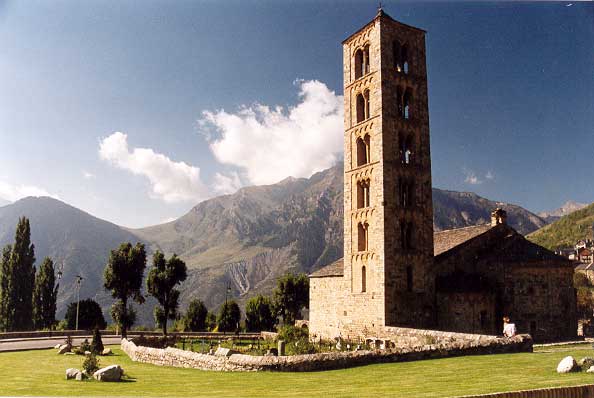
The Medieval church of Sant Climent de Taüll, located at the foothills of the Pyrenees, in the province of Lleida
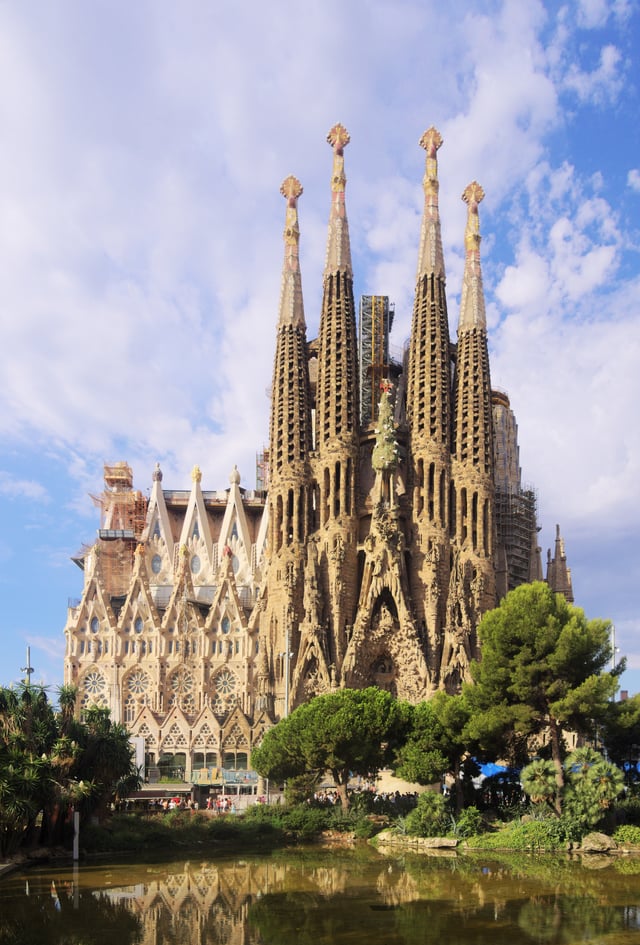
Sagrada Família, Barcelona
There are several UNESCO World Heritage Sites in Catalonia:
Archaeological Ensemble of Tarraco, Tarragona
Catalan Romanesque Churches of the Vall de Boí, Lleida province
Poblet Monastery, Poblet, Tarragona province
Works of Lluís Domènech i Montaner: Palau de la Música Catalana, Barcelona Hospital de Sant Pau, Barcelona
Works of Antoni Gaudí: Sagrada Família, Barcelona Parc Güell, Barcelona Palau Güell, Barcelona Casa Milà (La Pedrera), Barcelona Casa Vicens, Barcelona Casa Batlló, Barcelona The Church of Colònia Güell, Santa Coloma de Cervelló, Barcelona province
Literature
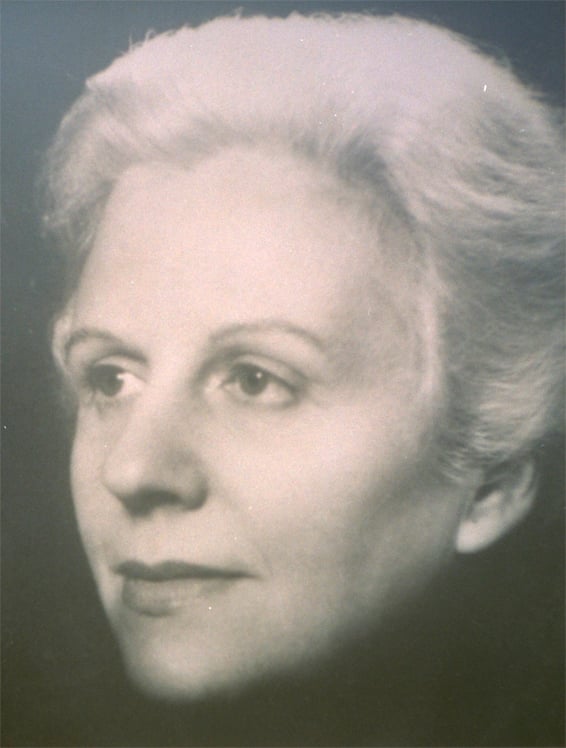
Mercè Rodoreda

Ana María Matute
Literary use of the Catalan language is considered to have started with the religious text known as Homilies d'Organyà, written either in late 11th or early 12th century.
There are two historical moments of splendor of Catalan literature. The first begins with the historiography chronicles of the 13th century (chronicles written between the thirteenth and fourteenth centuries narrating the deeds of the monarchs and leading figures of the Crown of Aragon) and the subsequent Golden Age of the 14th and 15th centuries. After that period, between the 16th and 19th centuries the Romantic historiography defined this era as the Decadència, considered as the "decadent" period in Catalan literature because of a general falling into disuse of the vernacular language in cultural contexts and lack of patronage among the nobility.
The second moment of splendor began in the 19th century with the cultural and political Renaixença (Renaissance) represented by writers and poets such as Jacint Verdaguer, Narcís Oller, Joan Maragall and Àngel Guimerà. During the 20th century were developed the avant-garde movements initiated by the Generation of '14 (called Noucentisme in Catalonia), represented by Eugeni d'Ors, Joan Salvat-Papasseit, Josep Carner, Carles Riba, J.V. Foix and others. During the dictatorship of Primo de Rivera, the Civil War (Generation of '36) and the Francoist period, Catalan literature is maintained despite the repression against the Catalan language, being often produced in exile.
The most outstanding authors of this period are Salvador Espriu, Josep Pla, Josep Maria de Sagarra (the latter three being considered as the main responsible of the renewal of Catalan prose), Mercè Rodoreda, Joan Oliver Sallarès or "Pere Quart", Pere Calders, Gabriel Ferrater, Manuel de Pedrolo, Agustí Bartra or Miquel Martí i Pol. In addition, several foreign writers who fought in the framework of the International Brigades then recount their experiences of fighting in their works, historical or fictional, with for example Homage to Catalonia of the British George Orwell in 1938 or Le Palace in 1962 and The Georgics in 1981 by Frenchman Claude Simon.
After the transition to democracy (1975–1978) and the restoration of the Generalitat (1977), literary life and the editorial market have returned to normality and literary production in Catalan is being bolstered with a number of language policies intended to protect Catalan culture. Besides the aforementioned authors, other relevant 20th-century writers of the Francoist and democracy periods include Joan Brossa, Agustí Bartra, Manuel de Pedrolo, Pere Calders or Quim Monzó.
Ana María Matute, Jaime Gil de Biedma, Manuel Vázquez Montalbán and Juan Goytisolo are among the most prominent Catalan writers in the Spanish language since the democratic restoration in Spain.
Festivals and public holidays
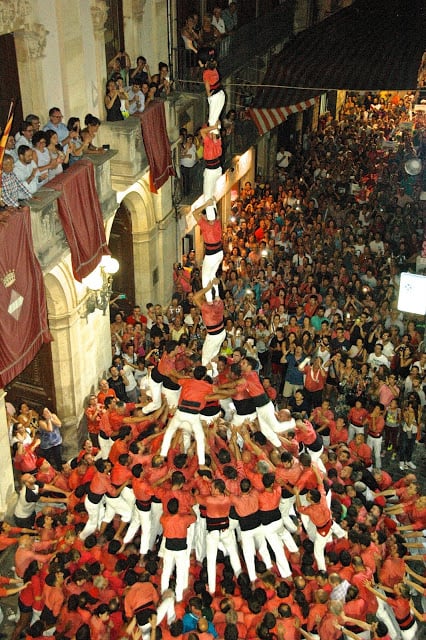
Castell 4 de 9 amb folre i pilar by Colla Vella de Valls
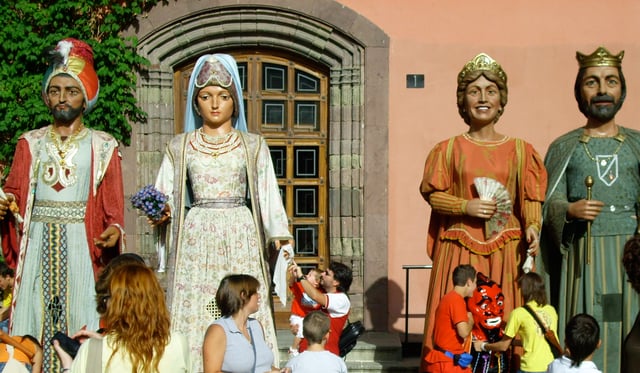
Gegants i capgrossos during the festa major of La Seu d'Urgell
Castells are one of the main manifestations of Catalan popular culture. The activity consists in constructing human towers by competing colles castelleres (teams). This practice originated in Valls, on the region of the Camp de Tarragona, during the 18th century, and later it was extended along the next two centuries to the rest of the territory. The tradition of els Castells i els Castellers was declared Masterpiece of the Oral and Intangible Heritage of Humanity by UNESCO in 2010.
In the greater celebrations other elements of the Catalan popular culture are usually present: the parades of gegants (giants) and correfocs of devils and firecrackers. Another traditional celebration in Catalonia is La Patum de Berga, declared Masterpiece of the Oral and Intangible Heritage of Humanity by UNESCO on 25 November 2005.[177]
There are some local Christmas traditions; one of them is the popular figure of the Tió de Nadal, consisting in a hollow log which after few days taking care of it, during Christmas Day or on Christmas Eve one orders it to defecate presents and, in order to make this, children beats the tió with sticks, while they singing various traditional songs. Another custom is to make a pessebre (Nativity scene), and usually includes the caganer, a figurine depicted in the act of defecation.[178]
In addition to traditional local Catalan culture, traditions from other parts of Spain can be found as a result of migration from other regions, for instance the celebration of the Andalusian Feria de Abril in Catalonia.
On 28 July 2010, second only after the Canary Islands, Catalonia became another Spanish territory to forbid bullfighting. The ban, which went into effect on 1 January 2012, had originated in a popular petition supported by over 180,000 signatures.[179]
Music and dance
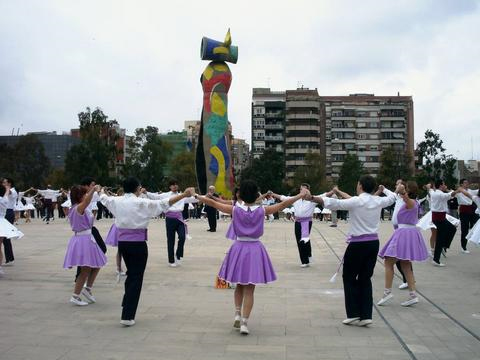
Sardana
The sardana is considered to be the most characteristic Catalan folk dance, interpreted to the rhythm of tamborí, tible and tenora (from the oboe family), trumpet, trombó (trombone), fiscorn (family of bugles) and contrabaix with three strings played by a cobla, and are danced in a circle dance. Other tunes and dances of the traditional music are the contrapàs (obsolete today), ball de bastons (the "dance of sticks"), the moixiganga, the goigs (popular songs), the galops or the jota in the southern part. The havaneres are characteristic in some marine localities of the Costa Brava, especially during the summer months when these songs are sung outdoors accompanied by a cremat of burned rum.
Art music was first developed, up to the nineteenth century and, as in much of Europe, in a liturgical setting, particularly marked by the Escolania de Montserrat. The main Western musical trends have marked these productions, medieval monodies or polyphonies, with the work of Abbot Oliba in the eleventh century or the compilation Llibre Vermell de Montserrat ("Red Book of Montserrat") from the fourteenth century. Through the Renaissance there were authors such as Pere Albert Vila, Joan Brudieu or the two Mateu Fletxa ("The Old" and "The Young"). Baroque had composers like Joan Cererols. The Romantic music was represented by composers such as Fernando Sor, Josep Anselm Clavé (father of choir movement in Catalonia and responsible of the music folk reviving) or Felip Pedrell.
Modernisme also expressed in musical terms from the end of the 19th century onwards, mixing folkloric and post-romantic influences, through the works of Isaac Albéniz and Enric Granados. The avant-garde spirit initiated by the modernists is prolonged throughout the twentieth century, thanks to the activities of the Orfeó Català, a choral society founded in 1891, with its monumental concert hall, the Palau de la Música Catalana in Catalan, built by Lluís Domènech i Montaner from 1905 to 1908, the Barcelona Symphony Orchestra created in 1944 and composers, conductors and musicians engaged against the Francoism like Robert Gerhard, Eduard Toldrà and Pau Casals.
Performances of opera, mostly imported from Italy, began in the 18th century, but some native operas were written as well, including the ones by Domènec Terradellas, Carles Baguer, Ramon Carles, Isaac Albéniz and Enric Granados. The Barcelona main opera house, Gran Teatre del Liceu (opened in 1847), remains one of the most important in Spain, hosting one of the most prestigious music schools in Barcelona, the Conservatori Superior de Música del Liceu. Several lyrical artists trained by this institution gained international renown during the 20th century, such as Victoria de los Ángeles, Montserrat Caballé, Giacomo Aragall and Josep Carreras.
Cellist Pau Casals is admired as an outstanding player. Other popular musical styles were born in the second half of the 20th century such as Nova Cançó from the 1960s with Lluís Llach and the group Els Setze Jutges, the Catalan rumba in the 1960s with Peret, Catalan Rock from the late 1970s with La Banda Trapera del Río and Decibelios for Punk Rock, Sau, Els Pets, Sopa de Cabra or Lax'n'Busto for Pop Rock or Sangtraït for hard rock, electropop since the 1990s with OBK and indie pop from the 1990s.
Media and cinema

Logo of Televisió de Catalunya
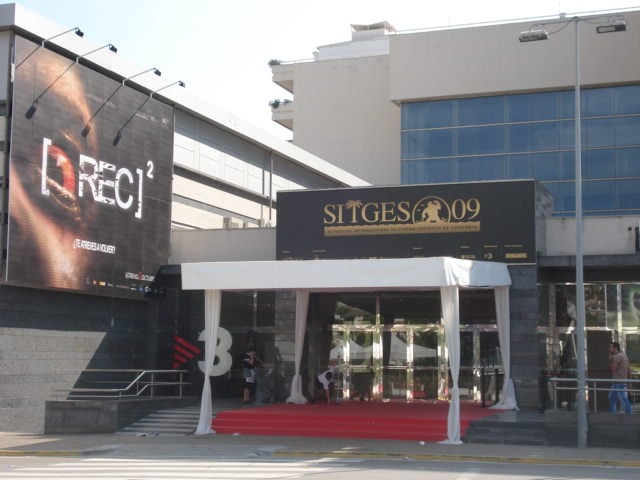
Sitges Film Festival of 2009
Catalonia is the autonomous community, along with Madrid, that has the most media (TV, Magazines, Newspapers etc.). In Catalonia there is a wide variety of local and comarcal media. With the restoration of democracy, many newspapers and magazines, until then in the hands of the Franco government, were recovered in order to convert them into free and democratic media, while local radios and televisions were implemented.
Televisió de Catalunya, which broadcasts entirely in the Catalan language, is the main Catalan public TV. It has five channels: TV3, El 33/Super3, 3/24, Esport3 and TV3CAT. In 2018, TV3 became the first television channel to be the most viewed one for nine consecutive years in Catalonia.[180][181] State televisions that broadcast in Catalonia in Spanish language include Televisión Española (with few emissions in Catalan), Antena 3, Cuatro, Telecinco, and La Sexta. Other smaller Catalan television channels include; 8TV (owned by Grup Godó), El Punt Avui TV, Barça TV and the local televisions, the greatest exponent of which is betevé, the TV channel of Barcelona, which also broadcasts in Catalan.
The two main Catalan newspapers of general information are El Periódico de Catalunya and La Vanguardia, both with editions in Catalan and Spanish. Catalan only published newspapers include Ara and El Punt Avui (from the fusion of El Punt and Avui in 2011), as well as most part of the local press. The Spanish newspapers, such as El País, El Mundo or La Razón, can be also acquired.
Catalonia has a long tradition of use of radio, the first regular regular radio broadcast in the country was from Ràdio Barcelona in 1924.[182] Today, the public Catalunya Ràdio (owned by Catalan Media Corporation) and the private RAC 1 (belonging to Grup Godó) are the two main radios of Catalonia, both in Catalan.
Regarding the cinema, after the democratic transition, three styles have dominated since then. First, auteur cinema, in the continuity of the Barcelona School, emphasizes experimentation and form, while focusing on developing social and political themes. Worn first by Josep Maria Forn or Bigas Luna, then by Marc Recha, Jaime Rosales and Albert Serra, this genre has achieved some international recognition. Then, the documentary became another genre particularly representative of contemporary Catalan cinema, boosted by Joaquim Jordà i Català and José Luis Guerín. Later, horror films and thrillers have also emerged as a specialty of the Catalan film industry, thanks in particular to the vitality of the Sitges Film Festival, created in 1968. Several directors have gained worldwide renown thanks to this genre, starting with Jaume Balagueró and his series REC (co-directed with Valencian Paco Plaza), Juan Antonio Bayona and El Orfanato or Jaume Collet-Serra with Orphan, Unknown and Non-Stop.
Catalan actors have shot for Spanish and international productions, such as Sergi López.
The Museum of Cinema - Tomàs Mallol Collection (Museu del Cinema - Col.lecció Tomàs Mallol in Catalan) of Girona is home of important permanent exhibitions of cinema and pre-cinema objects. Other important institutions for the promotion of cinema are the Gaudí Awards (Premis Gaudí in Catalan, which replaced from 2009 Barcelona Film Awards themselves created in 2002), serving as equivalent for Catalonia to the Spanish Goya or French César.
Philosophy
Seny is a form of ancestral Catalan wisdom or sensibleness. It involves well-pondered perception of situations, level-headedness, awareness, integrity, and right action. Many Catalans consider seny something unique to their culture, is based on a set of ancestral local customs stemming from the scale of values and social norms of their society.
Sport
Despite the fact that the most popular sports are represented outside by the Spanish national teams, Catalonia can officially play as itself in some others, like korfball, futsal or rugby league.[183] Most of Catalan Sports Federations have a long tradition and some of them participated in the foundation of international sports federations, as the Catalan Federation of Rugby, that was one of the founder members of the Fédération Internationale de Rugby Amateur (FIRA) in 1934.[184] The majority of Catalan sport federations are part of the Sports Federation Union of Catalonia (Catalan: Unió de Federacions Esportives de Catalunya), founded in 1933.
The Catalan Football Federation also periodically fields a national team against international opposition, organizing friendly matches. In the recent years they have played with Bulgaria, Argentina, Brazil, Basque Country, Colombia, Nigeria, Cape Verde and Tunisia. The biggest football clubs are FC Barcelona (also known as Barça), who have won five European Cups (UEFA Champions League), and RCD Espanyol, who have twice been runner-up of the UEFA Cup. Both play in La Liga.
The Catalan waterpolo is one of the main powers of the Iberian Peninsula. The Catalans won triumphs in waterpolo competitions at European and world level by club (the Barcelona was champion of Europe in 1981/82 and the Catalonia in 1994/95) and national team (one gold and one silver in Olympic Games and World Championships). It also has many international synchronized swimming champions.
Motorsport has a long tradition in Catalonia, which involving many people, with some world champions and several competitions organized since the beginning of the 20th century. The Circuit de Catalunya, built in 1991, is one of the main motorsport venues, holding the Catalan motorcycle Grand Prix, the Spanish F1 Grand Prix, a DTM race, and several other races.
Catalonia hosted many relevant international sport events, such as the 1992 Summer Olympics in Barcelona, and also the 1955 Mediterranean Games, the 2013 World Aquatics Championships or the 2018 Mediterranean Games. It held annually the fourth-oldest still-existing cycling stage race in the world, the Volta a Catalunya (Tour of Catalonia).[185]
Symbols
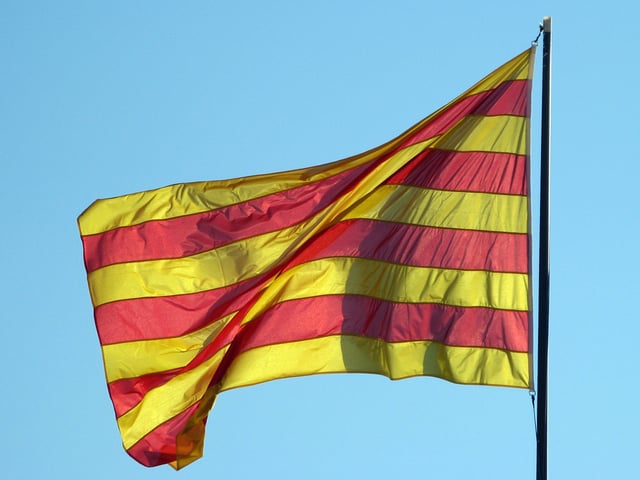
Flag of Catalonia
Catalonia has its own representative and distinctive national symbols such as:[186]
The flag of Catalonia, called the Senyera, is a vexillological symbol based on the heraldic emblem of Counts of Barcelona and the coat of arms of the Crown of Aragon, which consists of four red stripes on a golden background. It has been an official symbol since the Statute of Catalonia of 1932.
The National Day of Catalonia[187] is on 11 September, and it is commonly called la Diada. It commemorates the 1714 Siege of Barcelona defeat during the War of the Spanish Succession.
The national anthem of Catalonia is Els Segadors and was written in its present form by Emili Guanyavents in 1899. The song is official by law from 25 February 1993.[188][189] It is based on the events of 1639 and 1640 during the Catalan Revolt.
St George's Day (Diada de Sant Jordi) is widely celebrated in all the towns of Catalonia on 23 April, and includes an exchange of books and roses between couples or family members.
Cuisine
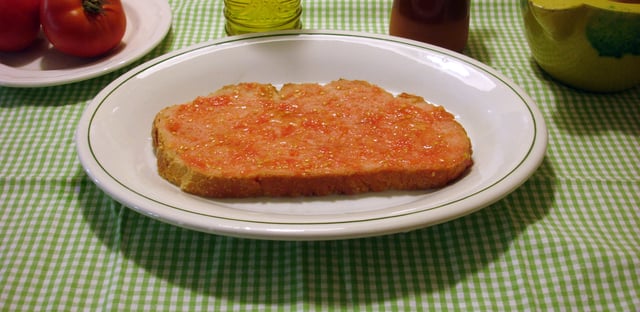
Pa amb tomàquet (bread with tomato)
Catalan gastronomy has a long culinary tradition. Various local food recipes have been described in documents dating from the fifteenth century. As with all the cuisines of the Mediterranean, Catatonian dishes make abundant use of fish, seafood, olive oil, bread and vegetables. Regional specialties include the pa amb tomàquet (bread with tomato), which consists of bread (sometimes toasted), and tomato seasoned with olive oil and salt. Often the dish is accompanied with any number of sausages (cured botifarres, fuet, iberic ham, etc.), ham or cheeses. Others dishes include the calçotada, escudella i carn d'olla, suquet de peix (fish stew), and a dessert, Catalan cream.
Catalan vineyards also have several Denominacions d'Origen wines, such as: Priorat, Montsant, Penedès and Empordà. There is also a sparkling wine, the cava.[190]
Catalonia is internationally recognized for its fine dining. Three of The World's 50 Best Restaurants are in Catalonia,[191] and four restaurants have three Michelin stars, including restaurants like El Bulli or El Celler de Can Roca, both of which regularly dominate international rankings of restaurants.[192]
Image gallery
Twinning and covenants
See also
Outline of Catalonia
List of people from Catalonia
Catalan Countries
List of European regions by GDP
Catalan Company




